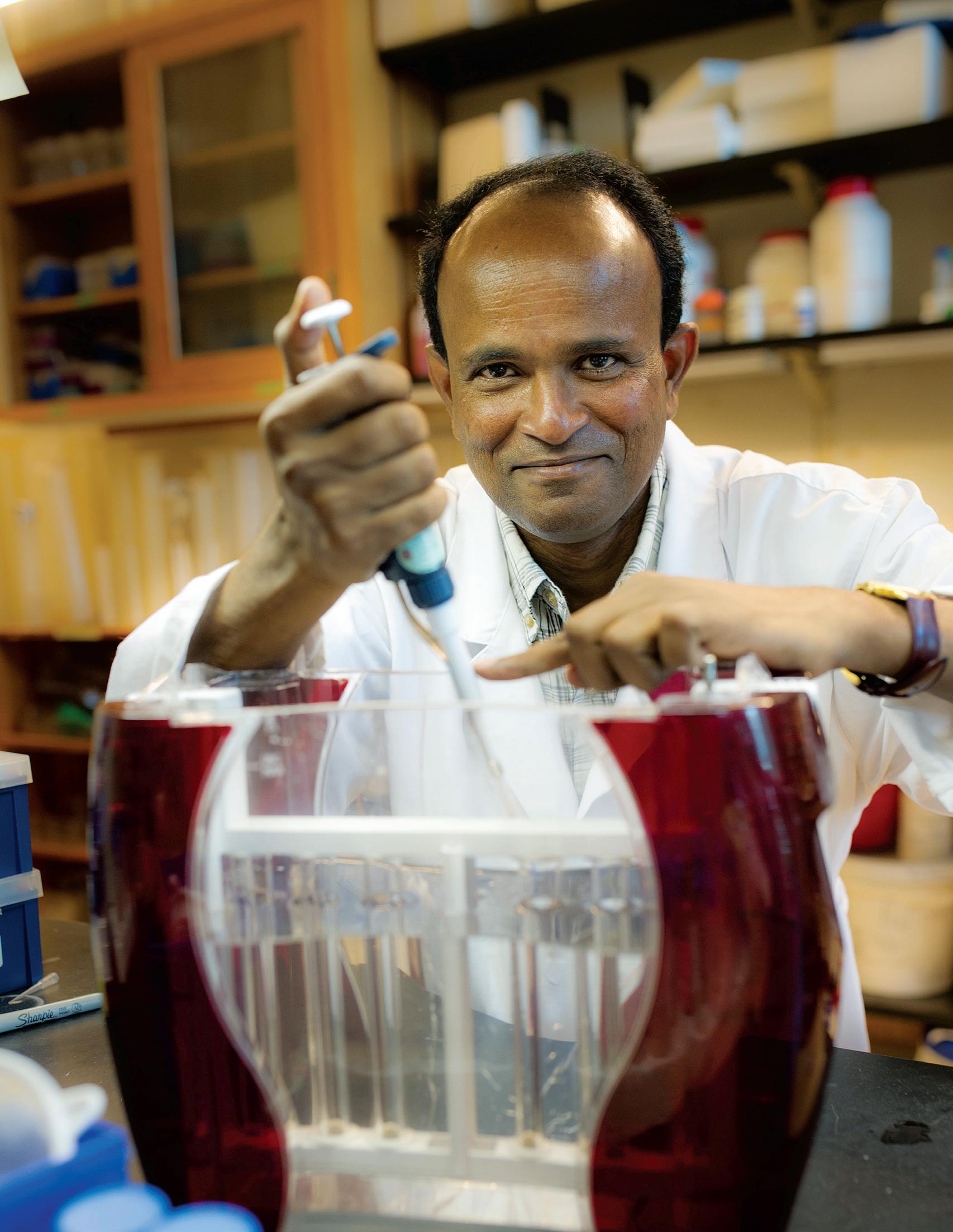
TAKING THE LEAD:
Ramanjulu Sunkar: Meet a biochemistry rock star
Research, scholarship and creative activity at Oklahoma State University 2015
Burns Hargis President
Sheryl Tucker Interim Vice President for Research and Dean of the Graduate College
Vanguard is published annually by Oklahoma State University and is produced by the Office of the Vice President for Research.
Editor/Writer: Jeff Joiner
Art Director/Designer: Dave Malec
Copy Editor: Dorothy Pugh
Photographers: Mandy Gross, Mitch Harrison, Todd Johnson, Gary Lawson, Phil Shockley, Katherine Taylor
Contributing Writers: Julie Barnard, Derinda Blakeney, Sonya Colberg, Jamie Hadwin, Sean Hubbard, Jeff Joiner, Laci Jones, Sean Kennedy, Christy Lang, Brian Petrotta, Chelsea Robinson, Donald Stotts
For details about research work highlighted in this magazine or reproduction permission, contact the editor. Jeff Joiner, Editor, Vanguard 405.744.5827; vpr@okstate.edu research.okstate.edu
Welcome to Vanguard magazine.
Thank you for taking the time to read the 2015 issue of Vanguard magazine. This annual publication covers just a few of the exciting, novel research projects underway throughout Oklahoma State University colleges and campuses. Vanguard only scratches the surface of the breadth of research activity going on at OSU that involves scientists and students who are doing important investigations today that we are likely to hear much more about in the future.

The office of the vice president of research has as an important role in providing leadership to facilitate OSU achievement of national prominence in all areas of research, scholarship and creative activities. It is an exciting challenge and one that I, as the interim vice president, embrace. The challenge to raise the bar of the university’s research reputation includes the continuous effort of our faculty to partner with industry, government and private-sector groups to ensure that as a landgrant university we are providing the knowledge necessary to improve the lives of our residents and the economies of Oklahoma and the nation.
Throughout these Vanguard stories, you will note the importance that OSU faculty and students place on research and scholarly endeavors that solve real-world problems facing communities, partner industries and society as a whole. The work of OSU researchers is making a difference in people’s lives. I am pleased to share with you in Vanguard magazine just a few of the life-impacting projects that are successfully raising the national prominence of research at Oklahoma State University.
Sheryl Tucker
Interim Vice President for Research and Dean of the Graduate College
Oklahoma State University, in compliance with Title VI and VII of the Civil Rights Act of 1964, Executive Order 11246 as amended, and Title IX of the Education Amendments of 1972 (Higher Education Act), the Americans with Disabilities Act of 1990, and other federal and state laws and regulations, does not discriminate on the basis of race, color, national origin, sex, age, sexual orientation, gender identity, religion, disability, or status as a veteran, in any of its policies, practices or procedures. This provision includes, but is not limited to admissions, employment, financial aid, and educational services. The following have been designated to handle inquiries regarding non-discrimination policies: Director of Equal Opportunity, 408 Whitehurst, OSU, Stillwater, OK 74078-1035; Phone 405-744-9154; email: eeo@okstate.edu. This publication, issued by Oklahoma State University as authorized by the Vice President for Research, was printed by Southwestern Stationery and Bank Supply at a cost of $5,180. (5M) 12/12. #4467
Research at Oklahoma State University • www.research.okstate.edu
2
On the cutting edge of his field, Ramanjulu Sunkar’s work is recognized by peers as vital to the future of their discipline.
6
8
10
OSU
13
14
18
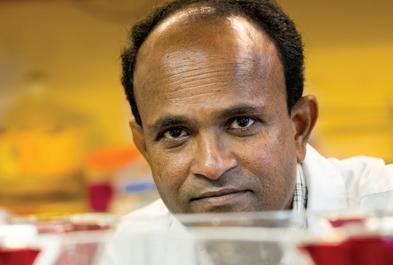
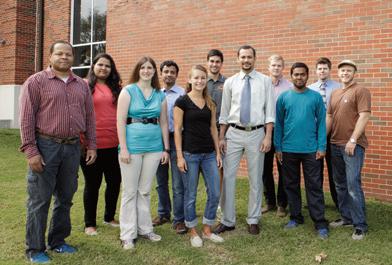
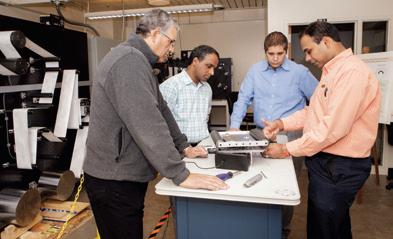
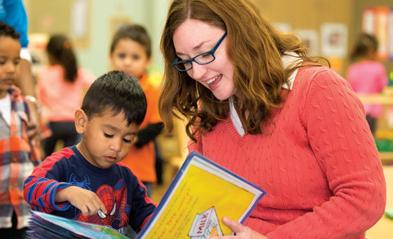
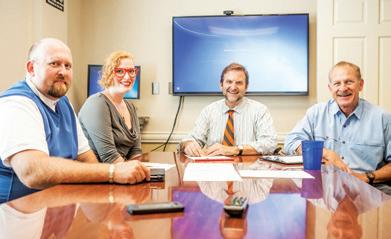
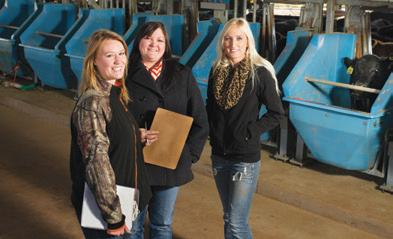
Sunkar Taking the Lead
Leveling the Field
Sifting through History
Targeting Cancer
scientists explore treating diseases with
drugs that limit
cells.
nanoparticle-delivered
harm to healthy
Swabbing for Clues
Spinning Off OSU Technology as a Startup Engineering entrepreneurs leverage OSU and state resources to take university-developed technology private.
Concrete Studies
Studying the Lives of Children and Families at Risk A researcher examines the social and emotional development of children and the importance of supportive family environments.
From Scratch to Market: Commercializing a Food Product 26 Raising Quality of Life Through Community Partnerships OSU faculty and students team with Coyle schools to encourage participation in and evaluation of community initiatives. 28 Diversity Pays Off 30 Living in Space 32 Researching How to Raise Cattle with Less Water Using genetics to develop beef cattle that are adaptable to drought.
Research Faculty Honored with Regents Distinguished Research awards 36 OSU Innovation Sets Another Royalty Record 37 Growing the Numbers BACK COVER The Nexus of Mathematics and Art TABLE OF CONTENTS Research, scholarship and creative activity at Oklahoma State University 2015 2 10 14 20 26 32 1 Research at Oklahoma State University • www.research.okstate.edu
20
22
34
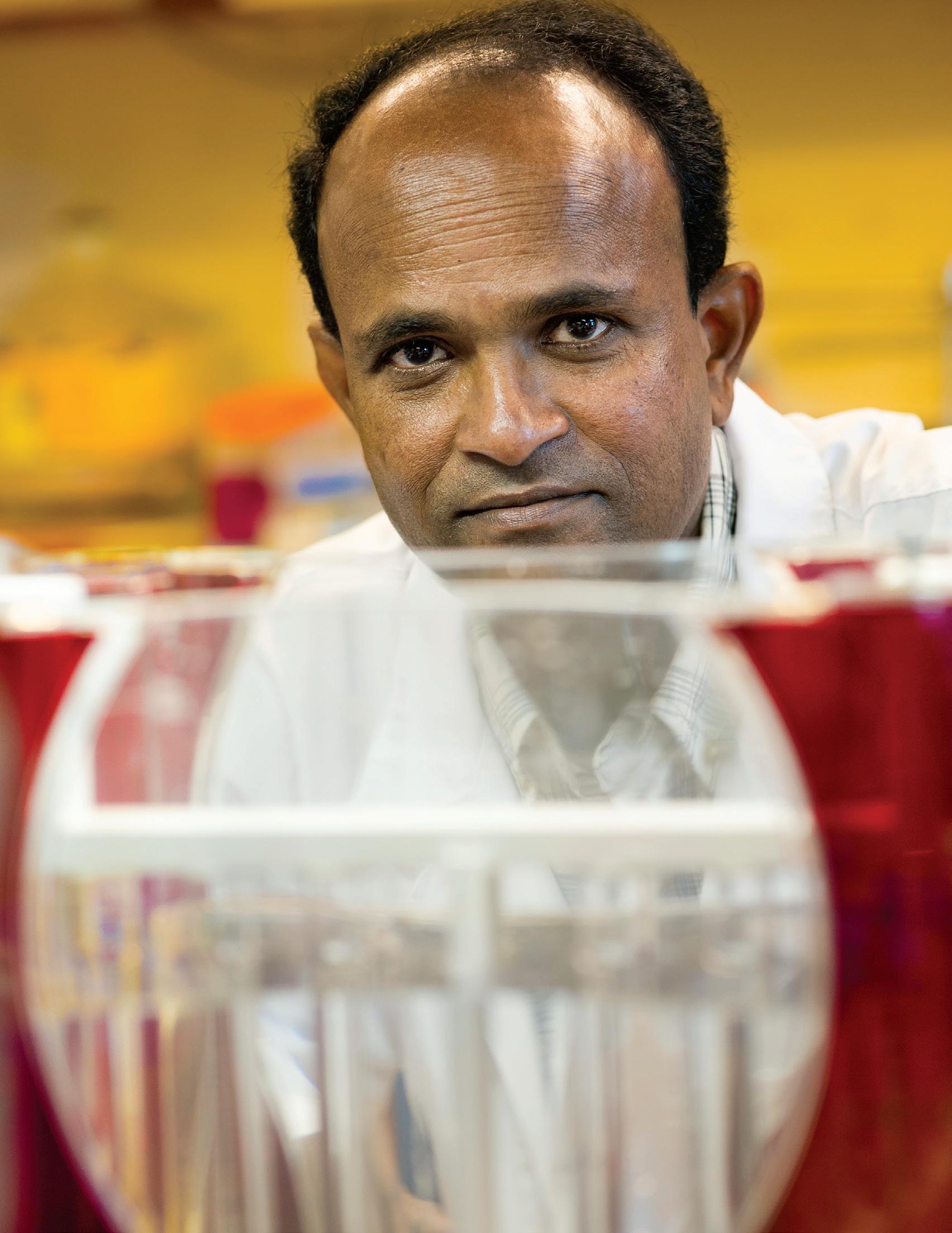
Research at Oklahoma State University • www.vpr.okstate.edu 2
“Dr. Sunkar is engaged in incredibly high-quality science and is truly having significant impacts on his field of study.”
—John Gustafson
Sunkar
TAKING THE LEAD
If Oklahoma State University’s Department of Biochemistry and Molecular Biology had a rock band, Ramanjulu
Sunkar would be the lead vocalist. If it had a baseball team playing in the World Series, he’s the one who would be coming to the plate with the bases loaded. He would be the main character in a blockbuster movie. Get it? He’s a big deal.
And most recently, he was included on the Thomson Reuters Highly Cited Researchers list for 2014. Sunkar, associate professor of biochemistry and molecular biology, has been cited by his peers nearly 6,500 times since 2009, putting him in the top 1 percent of researchers in his field.
“Dr. Sunkar is engaged in incredibly high-quality science and is truly having significant impacts on his field of study,” says John Gustafson, biochemistry and molecular biology department head. “Our department is extremely proud of him and his work since he joined us as a colleague in 2006.”
The Highly Cited list includes 3,200 researchers representing 21 fields in the sciences and social sciences. Sunkar, the first OSU faculty member to earn this acclaimed distinction, is among 80 named in the plant and animal science category.
“Our goal for the Division of Agricultural Sciences and Natural Resources is to continue building on our traditions of excellence. This honor for Dr. Sunkar’s research productivity and impacts gives further evidence that our scientists are achieving those aspirations,” says Thomas Coon, DASNR vice president, dean and director. “I commend him and his colleagues for the recognition they deserve.”
Sunkar isn’t one to sing his own praises. Still, he recognizes the significance of such an accomplishment.
“I am pleased and honored to be named on this list,” Sunkar said. “I’m also very excited about seeing where this research can take us.”
The researchers on this list are on the cutting edge of their fields, performing and publishing work their peers recognize as vital to the advancement of their scientific discipline. An extremely effective way of judging a researcher’s work is by looking at how often other researchers quote and cite him or her.
“Citation is a direct measure of influence on the literature of a subject, and it is also a strong indicator of scientific contribution, since it is derived from a pattern of
PHOTOS / TODD JOHNSON 3 Research at Oklahoma State University • www.vpr.okstate.edu
Much of Sunkar’s research is focused on drought, salt and heat tolerance in plants and involves using molecular techniques.
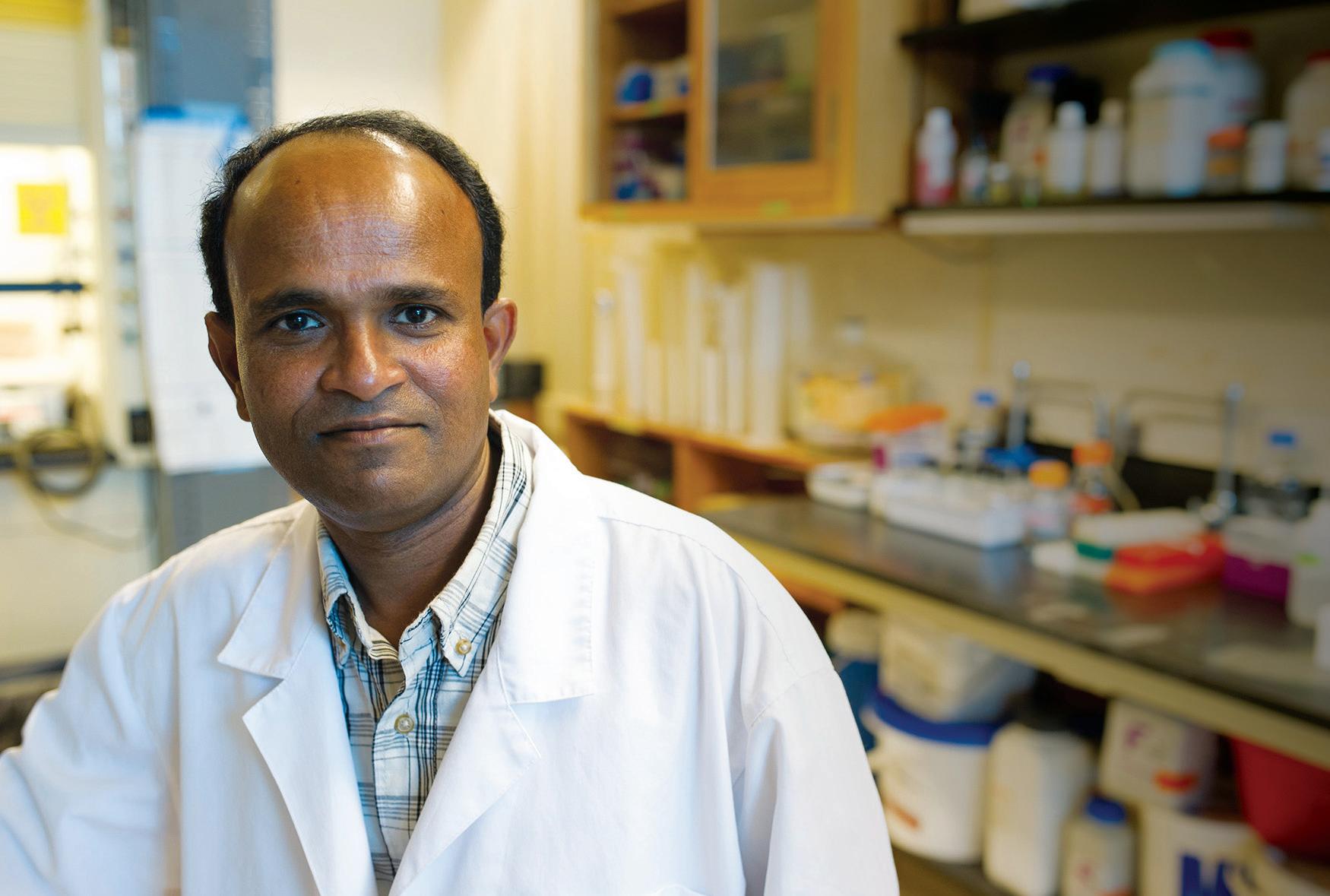
interaction among millions of published articles,” the Highly Cited website (www.highlycited.com) says. “Scientists who are often cited have more impact in their field and exert greater influence on their colleagues around the world.”
Sunkar has been cited by his peers nearly TIMES SINCE 2009 putting him in the top 1 percent of researchers in his field.
Much of Sunkar’s research is focused on drought, salt and heat tolerance in plants and involves using molecular techniques. Since plants can’t pack up and escape suboptimal environmental conditions, they must endure various environmental challenges such as increased soil salinity, drought and extreme temperatures.
A plant’s stress tolerance is determined by the proper spatial and temporal regulation of genes, producing optimal levels of response proteins. This is critical for plants to survive stressful conditions. As the global climate changes and the world population rises, available water sources are shrinking. Sunkar’s research is identifying properties plants possess that allow them to withstand many of the stressors they face.
“Dr. Sunkar’s work is very well received by his peers, since his research has uncovered a whole new class of gene regulators that many other scientists had not yet identified,” says Gustafson. “In addition, Dr. Sunkar now provides tools and observations required to uncover these gene regulators in a variety of other species, which other researchers benefit from.”
Some of his most popular work among his peers was the identification of miR156, a molecule in switchgrass,
Research at Oklahoma State University • www.vpr.okstate.edu 4
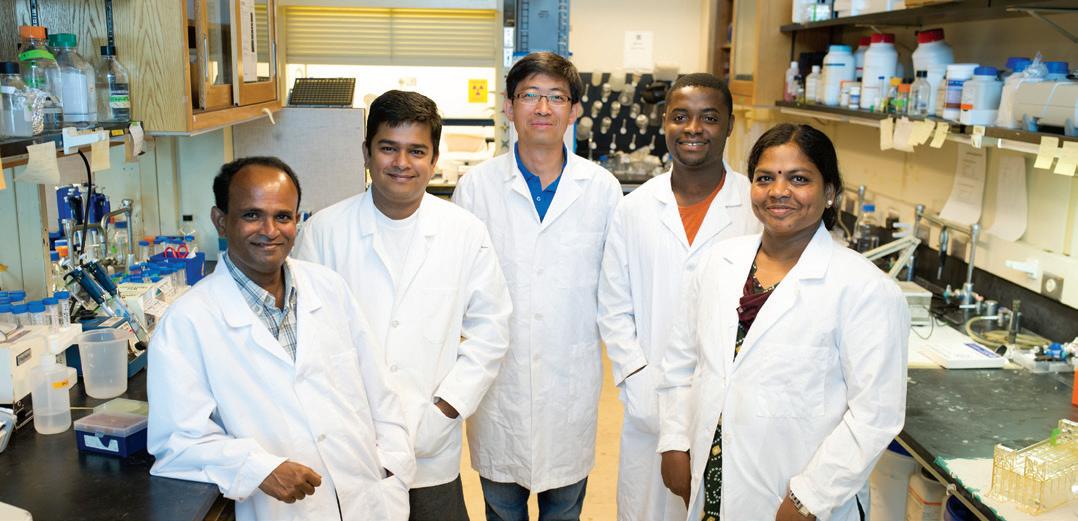
which, upon manipulation, leads to an increase in biomass production. The potential impacts of this discovery leave little doubt as to why Sunkar is becoming a worldwide name.
“The work that Dr. Sunkar is presently pursuing at OSU is exceptional. He is credited with the discovery of several new ‘microRNAs’ that were unknown to the plant community,” says Gustafson. “His laboratory also demonstrated that these relatively small gene regulators are able to control the expression of genes important to plant development and their ability to withstand stress.”
Proteins are important molecules in living organisms, especially multicellular life forms, which have numerous different cell types with varying functions.
“The various proteins, their differential quantities and the times they are produced in different cell types create the cell variability we observe in single multicellular organisms – such as people for instance,” Sunkar says. “The proteins are produced from the messenger RNA molecule, which in turn was produced as a result of activation of genes present in the DNA.”
Sounds simple, right?
“However, there is a layer of regulation between messenger RNA and protein, which has been discovered only recently. This newest level of gene regulation is mediated by the small molecules called ‘microRNAs,’ ” he says. “These molecules will determine where, when and how much of a specific protein needs to be produced, which is critical for the normal development of plant species, especially plants attempting to survive under stressful conditions.”
As Sunkar’s lab is responsible for the discovery of several new microRNAs in switchgrass, scientists from around the globe have been looking for these molecules in different plant species.
“If we have an understanding of it, we can move the technology forward with an educated public and produce crop varieties that can better withstand the stresses that a modern, transforming earth is putting on them,” Gustafson says. “Dr. Sunkar is the one creating and describing it to the scientific community so they can latch on.”
Sunkar’s research is a launching pad for opportunities in the biofuel market. With field trials taking place in Tennessee, the results are promising.
“Dr. Sunkar’s discoveries could have a huge impact in the future, when and if the research he pursues is applied to agriculturally important crops, which the population requires to feed themselves in an ever-changing planet,” Gustafson says. “In particular, application of his discoveries could lead to the production of safe, stress-tolerant crops or plants that produce more biomass. These stress-tolerant crops could potentially grow in warmer climates with less moisture, and the plants that produce more biomass could be utilized for alternative energy production.”
Until these new discoveries take hold and are put to good use, we can all sit back, give Sunkar a standing ovation and wait for his next act.
SEAN HUBBARD
Some of his most popular work among his peers was the identification of miR156, a molecule in switchgrass, which, upon manipulation, leads to an increase in biomass production.
V
miR156
5 Research at Oklahoma State University • www.vpr.okstate.edu
Members of Sunkar’s lab include (from left) Sunkar, postdoctoral fellows Shuavsish Chowdhury and Zhifang Wang, graduate student Robert Pokoo and postdoctoral fellow Vandana Hivrale.
THE Field Leveling
John Chaney’s AIIP program gives Native American students stronger shot at success
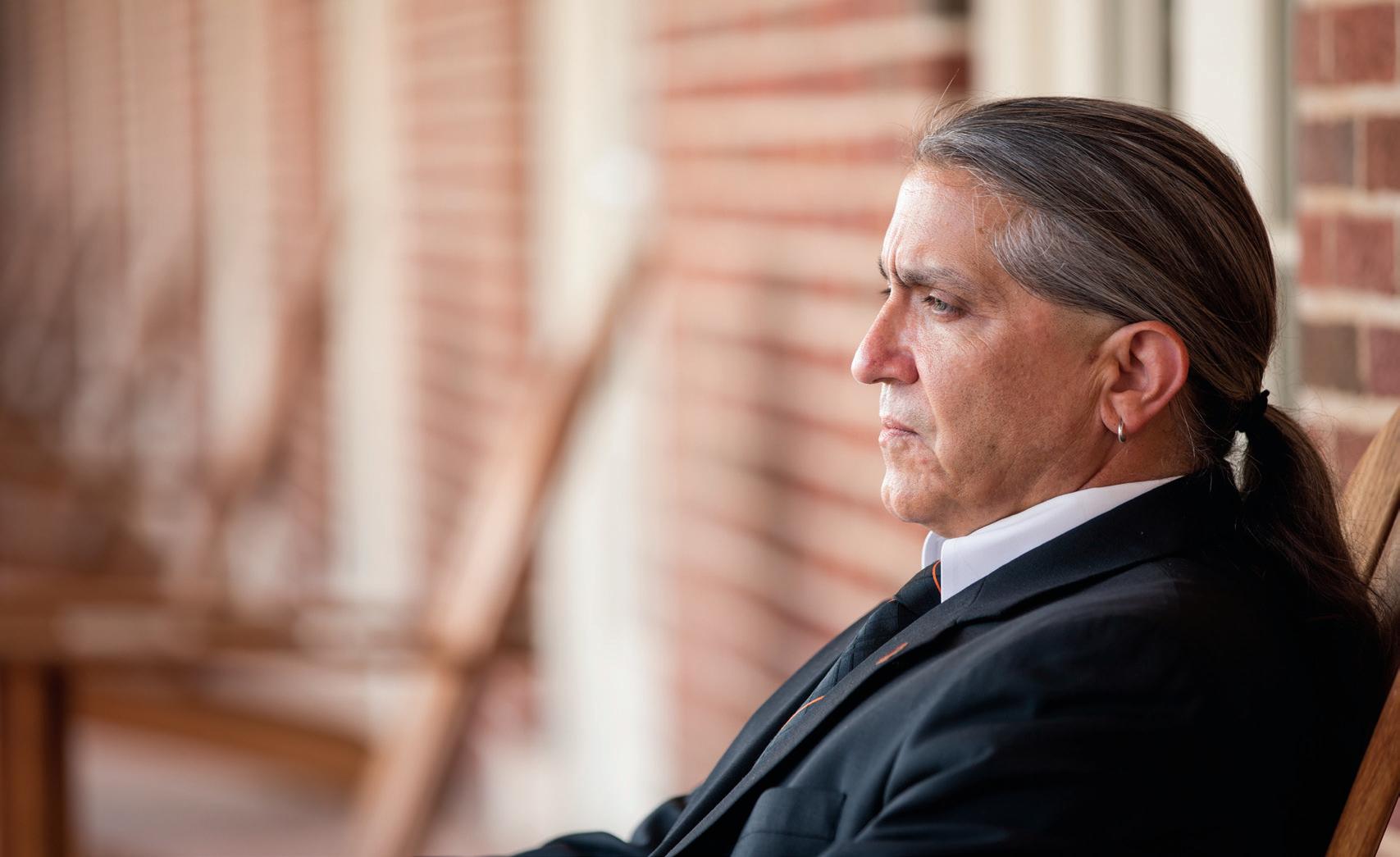
“It gave me not only an experience of what tribal behavioral health looked like but also provided networking opportunities.”
—Tamara Newcomb
“Ialways knew that I would want to find a way to contribute back to Native people.”
In 1997, John Chaney, Regents professor of psychology, launched the American Indians Into Psychology (AIIP) program at Oklahoma State University with the aid of a federal grant. Last fall, the Indian Health Services awarded OSU a $1.2 million grant to continue AIIP for another five years.
The AIIP is a unique opportunity for Native American students interested in psychology careers. It quickly blossomed in the late ’90s and has become a welloiled machine at OSU thanks to a collaborative — and largely volunteer — spirit within the Department of Psychology. The program’s success is one reason OSU graduates the most Native American psychology doctoral students in the country.
Of course, its success took
more than just financial backing.
“Just throwing money at the problem isn’t the answer,” Chaney says. “Preparing and giving them the mentoring experience that most students — but especially Indian students — don’t have levels the playing field.”
The AIIP at OSU works in two way: first, through graduate and undergraduate scholarships, and second, via an intensive summer enrichment program, which draws students from all over the country. Acceptance into the summer program is highly competitive and richly rewarding for those who attend.
“From the very beginning, it was geared toward making you successful,” says Evan White, a current OSU graduate student in psychology. White applied for the program his junior year and soon after his acceptance, he received a surprising phone call.
Research at Oklahoma State University • www.vpr.okstate.edu 6
PHOTO / PHIL SHOCKLEY
“Preparing and giving them the mentoring experience that most students — but especially Indian students — don’t have levels the playing field.”
—John Chaney
An undergraduate mentor at OSU reached out to him to make sure he knew what to expect when he arrived.
Such proactive assistance flows from the faculty to the graduate students to the undergraduates. Those who have succeeded in the program often later volunteer their time and expertise to AIIP. Clinical psychology graduate student Victoria O’Keefe, who identifies with both the Cherokee and Seminole tribes, says this across-the-board collaboration makes OSU’s program stand out.
“What was unique was I got a lot of information about how to get into graduate school from faculty and current graduate students, and I think getting that feedback definitely helped,” O’Keefe says.
The AIIP Summer Enrichment Program is an intensive, fiveweek primer covering everything a student might need to know about succeeding as a researcher and how to prepare for graduate school. Many are accepted into graduate school at OSU, though that is not a requirement of the summer program nor does participation guarantee a student will be accepted at OSU.
As the program’s prestige grows, competition heats up. Nearing its 20th year, the AIIP boasts an impressive list of graduates, including Tamara Newcomb, who serves as director of Behavioral Health Services for the Muscogee (Creek) Nation and on the AIIP advisory board. More than a decade removed from her
time in the summer program, Newcomb credits the boot camp-style experience with shaping her path.
“The program helped me understand what I wanted to do,” she says. “It gave me not only an experience of what tribal behavioral health looked like but also provided networking opportunities.”
Those opportunities include meeting representatives from various tribes around the state, which is an invaluable portion of the program. Other portions include directives on creating a curriculum vitae, guidance in studying for the GRE, teaching how to give a presentation, providing mock interviews and requiring a small research study. Essentially, after spending five weeks in Stillwater, participants in the program are wellgroomed for success as researchers and supreme graduate school candidates.
The goal in producing well-trained students is to eventually provide top-notch mental health care to underserved American Indian communities. With that in mind, Chaney requires candidates for the program to show how they have stayed connected with their tribes. O’Keefe, for instance, has
been a competitive powwow dancer since she was 5 years old. In fact, she was Head Lady Dancer at OSU’s Fall Contest Powwow two years ago.
“It’s your identity and your culture,” she says. “That was something my parents ingrained in me from a very young age.”
By drawing students from all over the country and many different tribes, participants in the AIIP summer program also have a chance to share their experiences and learn about others. White recalls during his turn in the summer program, one student from New Mexico had grown up on a reservation and was able to speak her native language.
“That type of cultural involvement was something we all benefited from,” he says.
The AIIP program has taken off at OSU because of interactions like that. Additionally, tremendous support from within the psychology department has greatly enriched the program. Faculty and graduate students volunteer their expertise. In fact, faculty members often ask Chaney about the candidates long before summer begins. V
BRIAN PETROTTA
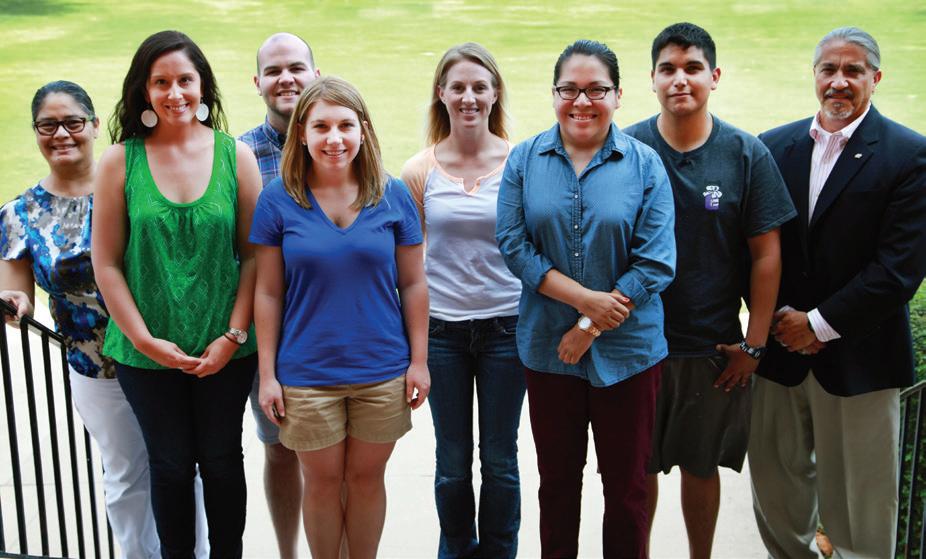 American Indians Into Psychology program director John Chaney (right) and graduate adviser Patricia Alexander (left) with OSU psychology graduate students who have participated in AIIP: (from left) Victoria O’Keefe, Sean Seabridge, Ashley Cole, Kristen Frosio, Ashleigh Coser and Trey Fogleman.
American Indians Into Psychology program director John Chaney (right) and graduate adviser Patricia Alexander (left) with OSU psychology graduate students who have participated in AIIP: (from left) Victoria O’Keefe, Sean Seabridge, Ashley Cole, Kristen Frosio, Ashleigh Coser and Trey Fogleman.
7 Research at Oklahoma State University • www.vpr.okstate.edu
PHOTO PROVIDED
James Cooper takes his research efforts to New England churches
Sifting THROUGH HISTORY
Summer is associated with vacations and family trips, a break from school and sometimes from work. James Cooper’s are often spent in hot attics, dark closets and musty basements.
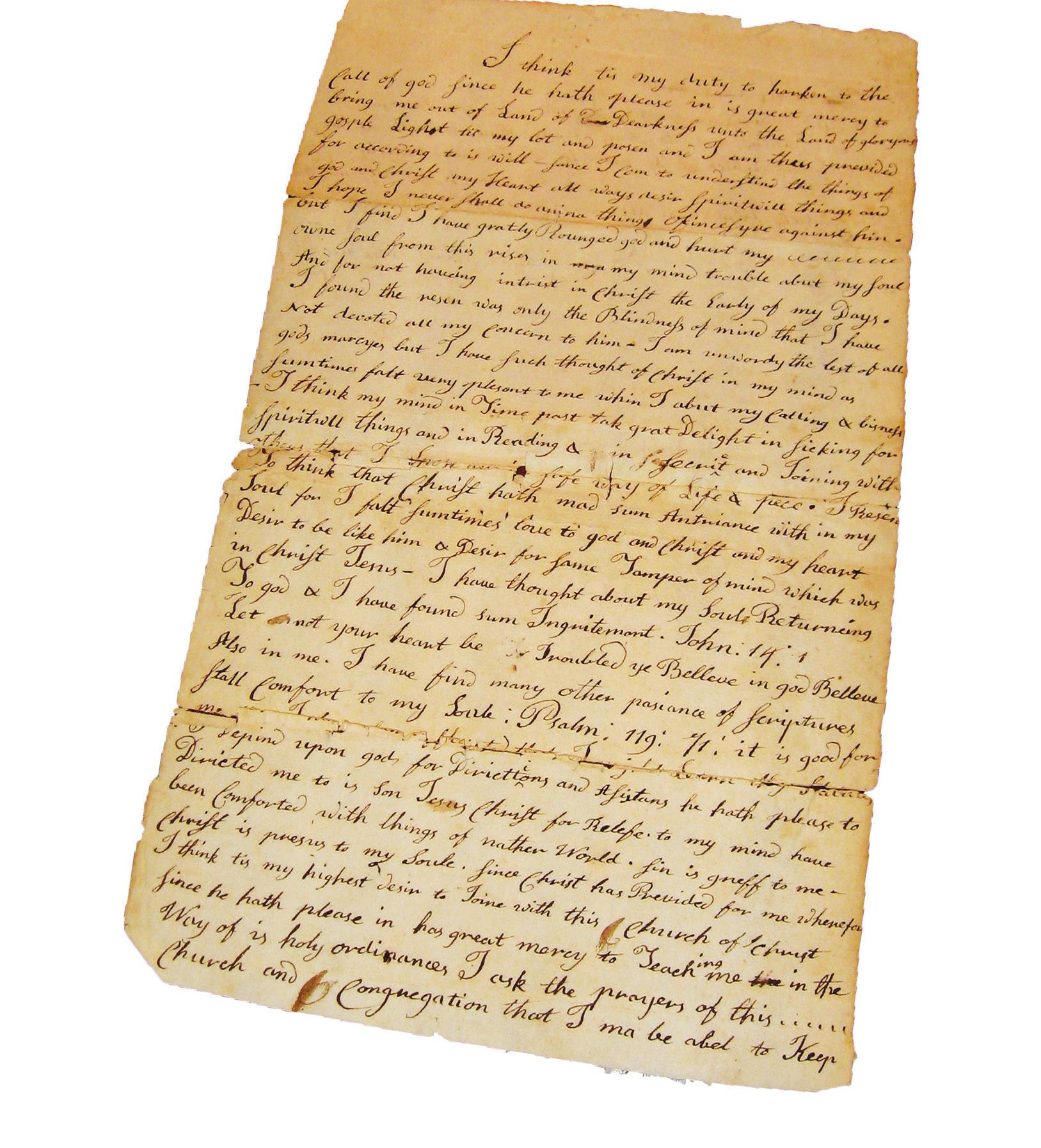
Since 1988, Cooper, a professor of history at Oklahoma State University, has spent his summers sifting through mountains of ledgers and church records in the file cabinets and closets of New England churches to preserve a piece of history. Many of these church documents offer a rare glimpse into colonial American life.
“In essence, we are making history by preserving history,” Cooper says.
Cooper is on a records-searching team with Margaret Bendroth, the executive director of the Congregational Library in Boston. The duo approach Massachusetts churches to persuade
church elders to lend records to the Congregational Library for digitization and preservation. The team hopes to expand into Connecticut and Maine in the near future.
Cooper has come away with some unexpected finds. A historian from a church in Middleborough, Mass., was at the Congregational Library to have the church’s ledgers digitized and mentioned a collection of relations the church possessed, wanting to know if Cooper would be interested in looking through them.
“Church ledgers, which are leatherbound books that contain birth and death records, admission records and minutes of church meetings … it is not unusual for them to survive,” Cooper says. “But loose, miscellaneous documents, like these relations, which are statements of faith that churchgoers
wrote out in the process of applying for church membership, are very rare. So I said, of course, I’d love to see them.”
In that largest collection of relations to surface in New England, he found what may be the only slave relation in existence that was written in the slave’s own hand (see document above). At the time of his membership request, Cuffee (the only name we know) was the minister’s slave. In order for Cuffee to have a better understanding of his faith and read the Bible, the minister taught him how to read and write. The fact that two rare circumstances are combined into one document was an unanticipated discovery, and Cooper is extremely grateful to have played a part.
Many of these ledgers and documents have been in the New England churches for more than 300 years. Cooper says sometimes his
“In essence, we are making history by preserving history.”
—James Cooper
Research at Oklahoma State University • www.vpr.okstate.edu 8
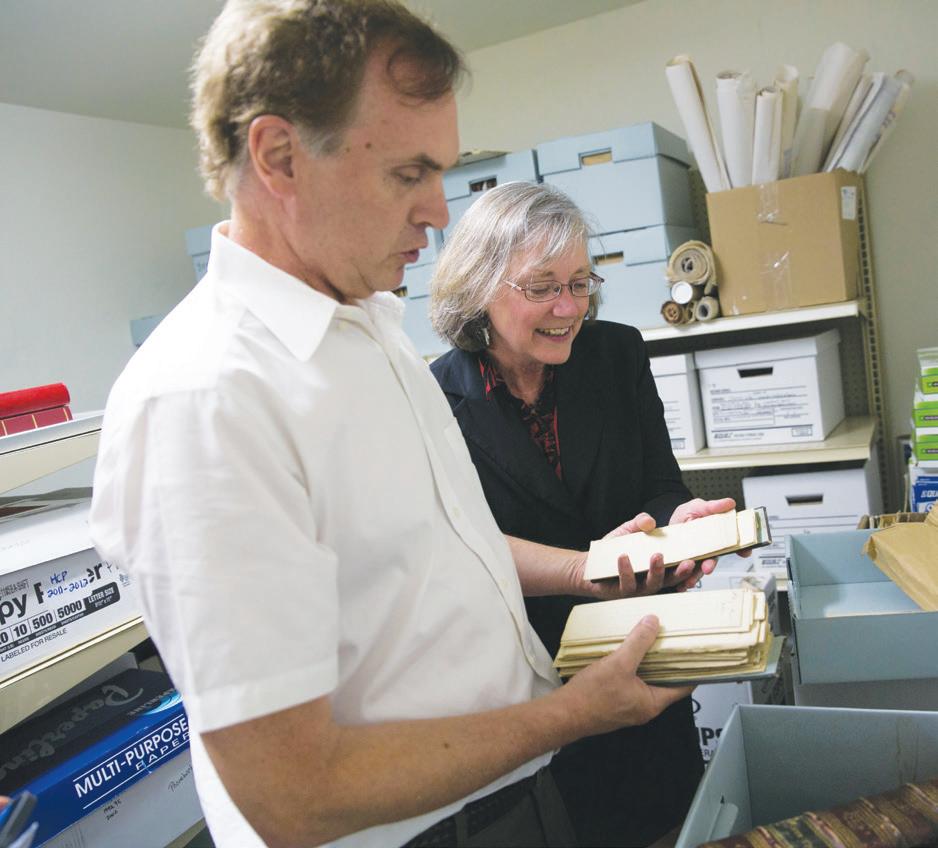
and Bendroth’s work, while mostly dealing with parchments and papers, also requires a firm understanding of human relations. Cooper explains to the churches that their records are of significance on state and national levels as well as to the local church and community. With very few exceptions, he has found the churches in the Northeast to be cooperative and reasonable in their willingness to have their records digitized. Many members are delighted to learn the importance of their church’s early history and are happy to give the documents the proper care they deserve.
Using an inventory that was created in the 1960s, Cooper approaches the New England churches with a fairly good idea of what documents they will have in their possession.
In Rowley, Mass., a church was rumored to possess a book containing the personal writings of a minister who was known for documenting everything. Because of the minister’s meticulous record-keeping, this book is considered one of the most important documents in early American history.
If two churchgoers had a dispute, the minister would invite them into his home to resolve the conflict. As soon as they left, he would record the events and discussions of the meeting as accurately as he could. He was, as Cooper says, a “virtual audio recorder.”
When Cooper arrived for his appointment at the church, the members had laid everything they had out on the table for him and gave him permission to look through the documents and see what he could take with him. The minister’s book was not there, and nobody knew where it was. The book resurfaced 17 years later after a local bank that was closing discovered an old book while clearing out its vaults. A teller remembered hearing how a local church was looking for a book that matched the description. The book was returned to the church and has since been digitized and preserved by the Congregational Library.
“I’ve been set loose in the vaults and closets of other churches, and there are just huge mounds of books and documents,” Cooper says. “I just have to commence the search, and I’ve made some amazing finds in that process.”
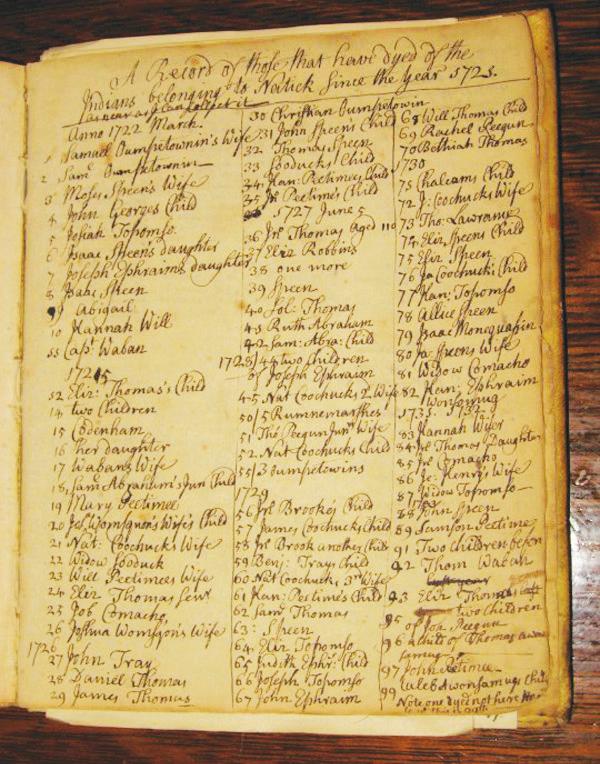
Many church records are lost due to fire, floods, burglary and other factors. Cooper, Bendroth and a full-time archivist at the Congregational Library work to bring in as many records as they can each summer to digitize and preserve. Currently, the digitization is being done through an outside vendor, but Cooper hopes to eventually be able to buy the equipment that will allow them to digitize records in house. This will save precious time and money.
This race against time will most likely keep Cooper busy for the rest of his life, he says, or at least until he retires. When he’s not digging through church records in New England or teaching at OSU, Cooper, an avid photographer and collector of retro video games, enjoys raising his three sons.
“I guess I was just born a collector,” Cooper says about his many hobbies and interests. “When you discover what you’re passionate about and you fill your time with those things, it’s hard to look back and not be happy you took on the challenges.” V
JAMIE HADWIN
Left: OSU history professor James Cooper and Margaret Bendroth look through early records at Faith Community Church in Hopkinton, Mass. The pair have worked together for years to find, digitize and preserve church records in New England for the Congregational Library and Archives in Boston. Above: A church ledger listing early 18th-century colonists killed in conflicts with Native Americans.
THE NEW YORK TIMES DOCUMENT PHOTOS/COURTESY JAMES COOPER
PHOTO/KATHERINE TAYLOR,
9 Research at Oklahoma State University • www.vpr.okstate.edu
TargetingCancer
OSU Center for Veterinary Health Sciences works to save lives both human and animal
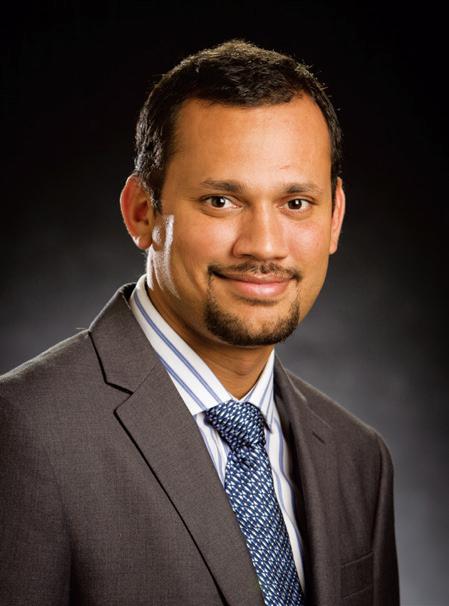
Most of us have known someone affected by cancer. Cancer knows no age limit, no financial boundaries and no mercy. But research is helping improve the way we treat this disease and others. And clinical veterinarians, researchers and students at Oklahoma State University’s Center for Veterinary Health Sciences are doing their part to help save lives, animal and human alike.
Ashish Ranjan leads a laboratory of researchers including an undergraduate student, two veterinary students, five Ph.D. candidates, a pre-doctoral fellow and two post-doctoral fellows. He also collaborates with others at in the veterinary center and across OSU. The assistant professor of physiological sciences secures funding through such sources as the National Institutes of Health (NIH), the Oklahoma Center for the Advancement of Science and Technology, and the Oklahoma Center for Respiratory and Infectious Diseases. His research focuses on targeting diseased cells using nanoparticles to deliver disease-fighting drugs.
“Current cancer therapy treatment usually relies on systemic delivery with limited tumor specificity,” says Ranjan. “This may result in adverse side effects in normal tissues and insufficient drug delivery to the targeted
cancerous tumor. Encapsulation of a chemotherapeutic agent into a nanoparticle has the potential to reduce systemic toxicity and enhance drug delivery. For cancer targeting, we are pursuing two parallel approaches to address this critical need. One involves development of image-guided drug delivery, and the other involves optimizing concurrent combinations of radiation and chemotherapy.”
For image-guided drug delivery, Ranjan’s team uses a simultaneous combination of drug encapsulated imageable nanocarriers with clinical imaging devices for more accurate targeting.
“Basically, our team is developing nanoparticles that can be imaged using ultrasound and simultaneously achieve drug delivery under image guidance. For example, a team member will use a liposome, which is a vesicle or a bubble, and fill it with a cancer-fighting drug that can be detected on ultrasound. Then, using a specialized ultrasound, we are able to achieve site-specific delivery, treating the diseased area directly without harming surrounding healthy cells. Our team is trying to perfect this new technique, which has the same amount of efficacy as current protocols but with zero side effects,” adds Ranjan.
Ashish Ranjan leads researchers investigating using nanoparticles to deliver targeted treatments for cancer and other diseases.
Research at Oklahoma State University • www.vpr.okstate.edu 10
PHOTOS / GARY LAWSON
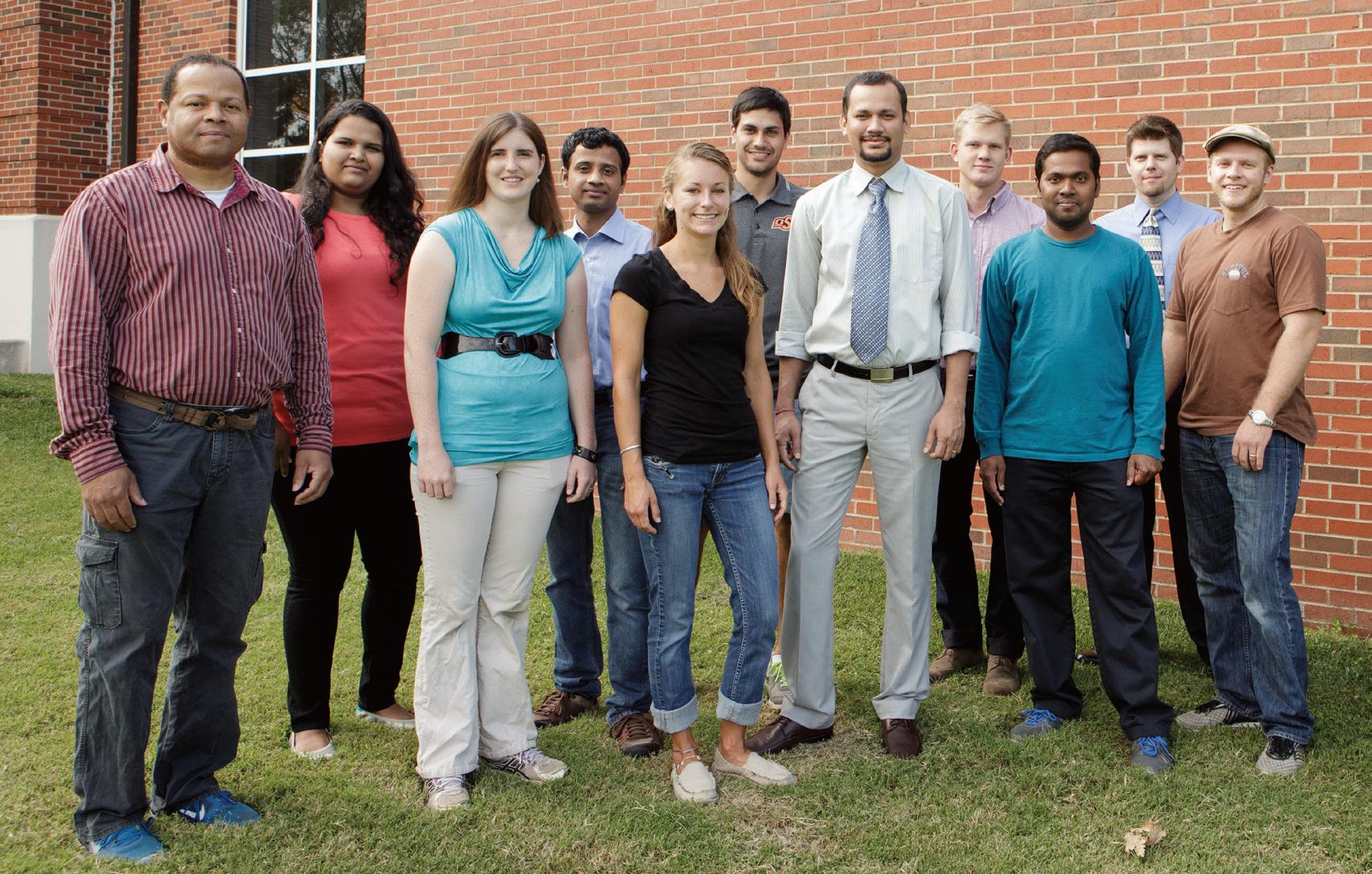
“Our team is trying to perfect this new technique, which has the same amount of efficacy as current protocols but with zero side effects.”
—Ashish Ranjan
Similarly, the concept of concurrent combinations of radiation and chemotherapy is based on the premise that radiation can be leveraged to localize nanoparticles in tumors and trigger drug release from them.
“The ability to achieve non-toxic, selective chemotherapy with realtime assessment has applications in a variety of diseases including cancer. Our lab realizes this potential and while research on cancer constitutes the primary area of work, we are also investigating the therapeutic application of nanomedicine against chronic infection and thrombotic disease,” says Ranjan.
Among those working in Ranjan’s lab is Peter Czajkowski, a second-year veterinary student from Peachtree Corners, Ga. Czajkowski applied the
nanotechnology to see if it could treat thrombolysis by effectively breaking down blood clots in patients both animal and human. His original study was part of a 12-week Summer Research Training Program for first- and secondyear veterinary students. He soon discovered that research can take you down unexpected paths.
“It was a great experience,” says Czajkowski. “The one thing I walked away from this knowing was how much work goes into a research project. Originally I thought it would be easily done in the three-month period. Realistically, it is not done. So I am taking an elective to do a follow-up study that will hopefully further improve this technique.”
“The Summer Research Training Program at OSU’s veterinary center
is a great initiative,” adds Ranjan. “It motivated Peter in such a way that he is continuing that project. The data which Peter generated and will come to generate can certainly be used for many other projects in our laboratory.”
“Medical applications of nanotechnology promise to revolutionize our ideas about healthcare delivery in both humans and in our veterinary patients in areas such as drug delivery or new technologies like nanoscale biosensors,” says Jerry Malayer, associate dean for research and graduate education. “Targeted drug delivery will reduce the amount of drug needed and possibly reduce side effects of drugs which could result in overall decreases in treatment costs. It is important for us to always be thinking about applications of new technologies
11 Research at Oklahoma State University • www.vpr.okstate.edu
Members of the Ranjan lab team include (from left): Willie Collins, Kalyani Ektate, Lauren Kuzimski, Kaustuv Sahoo, Michele Harbeson, Peter Czajkowski, Ashish Ranjan, Kevin McLean, Venkilesan Perumal, Danny Maples and Aaron Deese.
and staying close to the edge of scientific developments.”
Ranjan oversees several projects in his laboratory, all aimed at using nanomedicine to treat lifethreatening diseases. Here is a brief description of six such projects:
• Image-guided tumor drug delivery by ultrasounddetected heat-released liposome: This research focuses on developing an imageable nanoparticle for localizing and treating cancer in combination with a high-intensity focused ultrasound device. It is funded by the National Cancer Institute at NIH. Kevin Mclean, an undergraduate student and Wentz scholar, and Danny Maples, a chemistry major and pre-doctoral fellow, work with Ranjan on this project.
• Nanotherapeutic modulation of autophagy (or cell death) for treatment of lung pathogens: Chronic intracellular infection, such as tuberculosis, requires frequent administration of antibiotics for long durations such as six to nine months. To address this, the team is developing a multifunctional nanoplatform for targeting and killing chronic intracellular bacterial pathogens. The study is made possible through funding from the Oklahoma Center for Respiratory and Infectious Diseases, which was created from a NIH Centers for Biomedical Research Excellence grant. Working with Ranjan and Malayer are Ph.D. students Michele Harbeson and Willie Collins.
• Trackable nanocarriers for rational dosimetry (measurement of doses): Nanoparticles are normally tested in rodents. Attempts to translate the findings from rodent studies directly into humans have met with dismal clinical outcomes. This project focuses on determining the kinetics of echogenic liposomes in a clinically relevant large-animal tumor model
and compares the results with a rodent model to ease translation to human patients. Danny Maples, a chemistry major and pre-doctoral fellow, and Selvarani Ramasamy, a Ph.D. student, work with Ranjan on this study, which is funded by the Oklahoma State University Technology Business Development Program.
• Nanocarrier-mediated targeting of bioscavengers to the red blood cell for prolonged circulation and protection: This project will systematically design and characterize co-polymer nanoparticles encapsulating the bioscavenger enzyme BChE that can be selectively targeted to red blood cells. Once attached to or inside red blood cells, the nanoparticles will circulate in the blood for weeks to months, providing prolonged and enhanced protection against organophosphate intoxication.
“Medical applications of nanotechnology promise to revolutionize our ideas about health care delivery in both humans and in our veterinary patients.”
—Jerry Malayer
• Dual-mode ultrasoundimageable thermosensitive liposomes for image-guided therapy: Prostate cancer is one of the most common cancers among men in United States. Current therapy results in significant morbidity among patients. This research is investigating the thermal enhancement of chemotherapy under image guidance with an overall goal of dose reduction and increasing survival rates. Working with Ranjan are Kalyani Ektate and Aaron Deese, Ph.D. students, and Perumal Venkatesan, a post-doctoral fellow. The work is funded by the Oklahoma Center for the Advancement of Science and Technology.
To
Funded by the U.S. Department of Defense through the Defense Threat Reduction Agency, these researchers are collaborating on the project: Regents Professor Carey Pope (principal investigator); Ranjan and Jing Pope (co-investigator), all with the veterinary center’s Department of Physiological Sciences and Josh Ramsey of Chemical Engineering and Steve Hartson of Arts and Sciences. Also working on the project is Kaustuv Sahoo, a postdoctoral fellow in Ranjan’s lab.
• High-intensity focused ultrasound mediate clotlysis: Funded by OSU’s Center for Veterinary Health Sciences, this study aims to develop nanoparticles that can induce clot-lysis (or a blood clot) in combination with a high-intensity focused ultrasound. Second-year veterinary student Peter Czajkowski and third-year veterinary student Alison Gedney work with Ranjan on this research.
While the projects vary and the financial funding comes from different sources, the goals are the same: minimize side effects and enhance therapeutic outcomes in animals and humans. V
DERINDA BLAKENEY
role in fighting cancer and other life-threatening diseases by supporting veterinary medical research at OSU’s Center for Veterinary Health Sciences, contact
development, at 405-385-5607 or
Research at Oklahoma State University • www.vpr.okstate.edu 12
play a
Heather Clay, senior director of
hclay@osugiving.com.
Swabbing C ues for
Power Swab could help researchers identify criminals from trace DNA

Asimple device developed by forensic sciences researchers at OSU Center for Health Sciences in Tulsa could help law enforcement investigators identify suspects in thousands of unsolved crimes.
“Whenever a person touches a surface or object, they leave small flakes of skin or other biological material behind,” says Robert Allen, head of the School of Forensic Sciences at OSU-CHS. “The device we developed will enable crime scene investigators to better collect all of that material for DNA testing.”
The Power Swab uses a glass-infused fiber to collect the genetic material.
“Using glass is part of the standard DNA extraction methodology — DNA binds tightly to glass when mixed with a high-salt solution,” says Allen. “But nobody has tried using glass as part of the swab to gather evidence at the crime scene before.”
The School of Forensic Sciences offers advanced training for law enforcement investigators and laboratory technicians in several areas, including crime scene investigation and DNA analysis. The Power Swab project was a perfect combination of those two core areas.
“The research conducted by Dr. Allen and other researchers in the School of Forensic Sciences is focused on making the world a safer place,” says
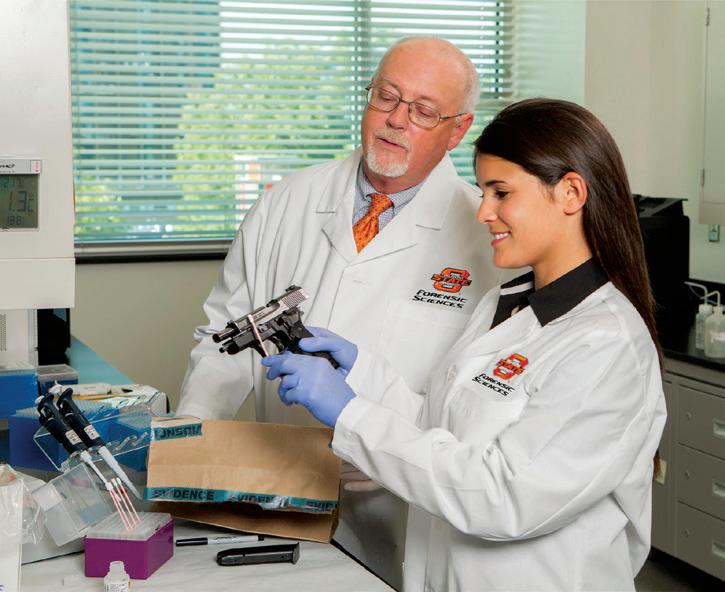
Dr. Kayse Shrum, president of OSUCHS. “The techniques our scientists are creating to help properly identify suspects will assist with prosecutions and could ultimately remove more criminals from the streets.”
When working with such tiny amounts of evidence (such as a few skin flakes, saliva or a drop of blood), it is critical to collect as much of the biological material as possible to create a complete DNA profile.
Previous research Allen had conducted showed that the amount of trace DNA left at a crime scene varies based on genetics, gender, hygiene and other factors. This variability is another factor that makes it important to collect all the DNA evidence a suspect leaves behind.
“Investigators have used several different means to collect trace DNA, like tape, but the effectiveness varied,” says Allen. “Some labs avoid working with trace DNA because it is so difficult to get a complete DNA profile. We hope that changes with these swabs.”
Allen believes the swabs could prove useful for investigations of robberies, improvised explosive devices and other crimes where the only evidence of the suspect might be trace DNA.
“We really think the Power Swab will have a major impact on the investigations of these types of crimes,” he says. “By collecting all the DNA at a crime scene, we should be able
to increase the percentage of cases that have a complete DNA profile.”
Those profiles can be entered in the national DNA database to see if they match with any known offenders. If the sample does not match, it will create a criminal profile in the event the suspect commits any other crimes.
The concept for the Power Swab originated when a graduate student, Rachel Powers, needed a project to work on as part of her graduate degree program. Allen thought the project might produce some positive results since glass is commonly used in DNA extractions.
“The knowledge about the relationship between glass and DNA has been around since the 1970s, but we are the first to put that concept to use with a swab in the field,” says Allen.
OSU has applied for a patent and is in the process of partnering with a swab manufacturer to produce prototypes for testing in the field. Allen has contacted the U.S. Army Criminal Investigation Laboratory and entered into discussions about field-testing the Power Swabs.
“The Power Swab is an accessory for crime scene investigators that will make DNA analysis technology more dependable,” says Allen. “Field testing will enable us to see how it works for the investigators who will use it every day.” V
SEAN KENNEDY
Robert Allen, head of the School of Forensic Sciences at the OSU Center for Health Sciences, supervises as graduate student Rachel Powers swabs a gun for DNA.
13 Research at Oklahoma State University • www.vpr.okstate.edu
PHOTO/COURTESY OSU CENTER FOR HEALTH
SCIENCES
SPINNING OFF
TECHNOLOGY AS A STARTUP
A decade of work by faculty and grad students spawns a business
What makes a successful entrepreneur is a topic studied as much in business schools today, including Oklahoma State University’s Spears School of Business, as pinpointing genetic mutations responsible for disease is in biomedical research. A number of traits tag entrepreneurs as likely to succeed — energy, passion, discipline, perseverance — but a key is also the ability to leverage resources and organizations to nurture a business concept to maturity.
Sparked in part by a chance class on entrepreneurship at the Spears School of Business and developed with guidance and financial support from OSU and other public and private organizations, a technology startup
has become a case study for how university-developed technology can be incubated and spun off as a business. In the case of Roll-2-Roll Technologies, launched by a group of OSU graduate students and faculty, a support network of organizations helped develop a nascent technology business concept.
What began a decade ago by mechanical and aerospace engineering professor Prabhakar Pagilla to improve the handling of rolled materials in manufacturing has grown into the development of an advanced guide system for roll-to-roll machines. These machines make a variety of consumer products using such rolled materials as paper, plastic, metal, film and fabric.
“We’ve been working on this for almost 10 years,” says Pagilla. “This has been evolutionary, not revolutionary.”
Mechanical engineering student Aravind Seshadri, who came to Stillwater to earn a master’s degree, joined Pagilla’s research group to work on projects at OSU’s Web Handling Research Center, an industry partnership established to improve manufacturing using web, or roll-toroll machines. Pagilla and Seshadri developed improved sensor and control technology for web machine lateral guides, the devices that keep materials in-line during the highspeed manufacturing process, reducing downtime for manual realignment that wastes time, material and money. Their patented fiber optic sensor and control algorithm detect the position of the web and automatically control material alignment.
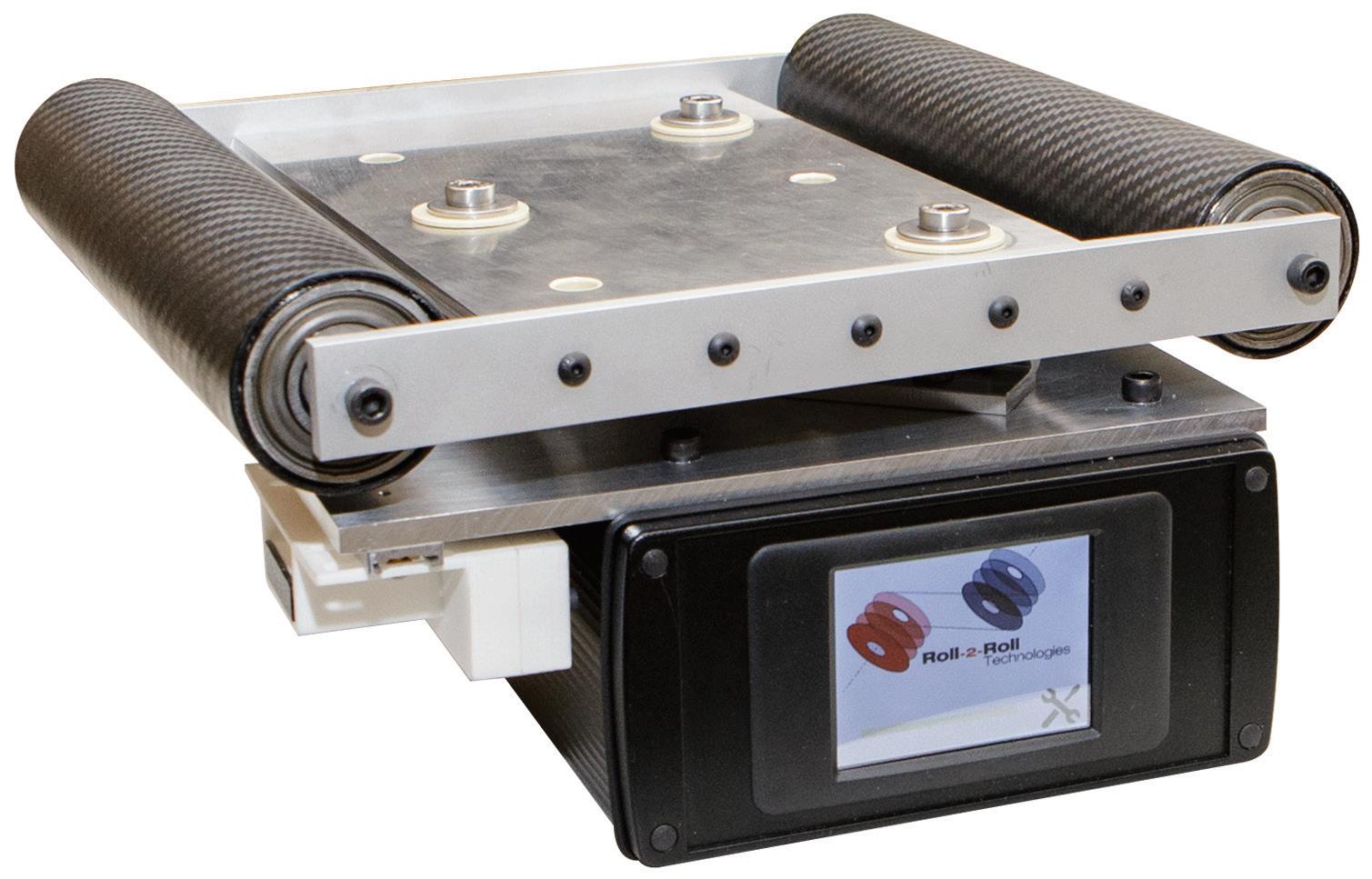
“We have developed components in the device that are substantially better than what are used on existing machines,” Pagilla says.
Roll-2-Roll Technologies has developed an improved lateral guide for manufacturing machines that use rolled materials. The OSU technology startup developed a patented optical sensor and controlling algorithm that is at the heart of the guide.
Research at Oklahoma State University • www.vpr.okstate.edu 14
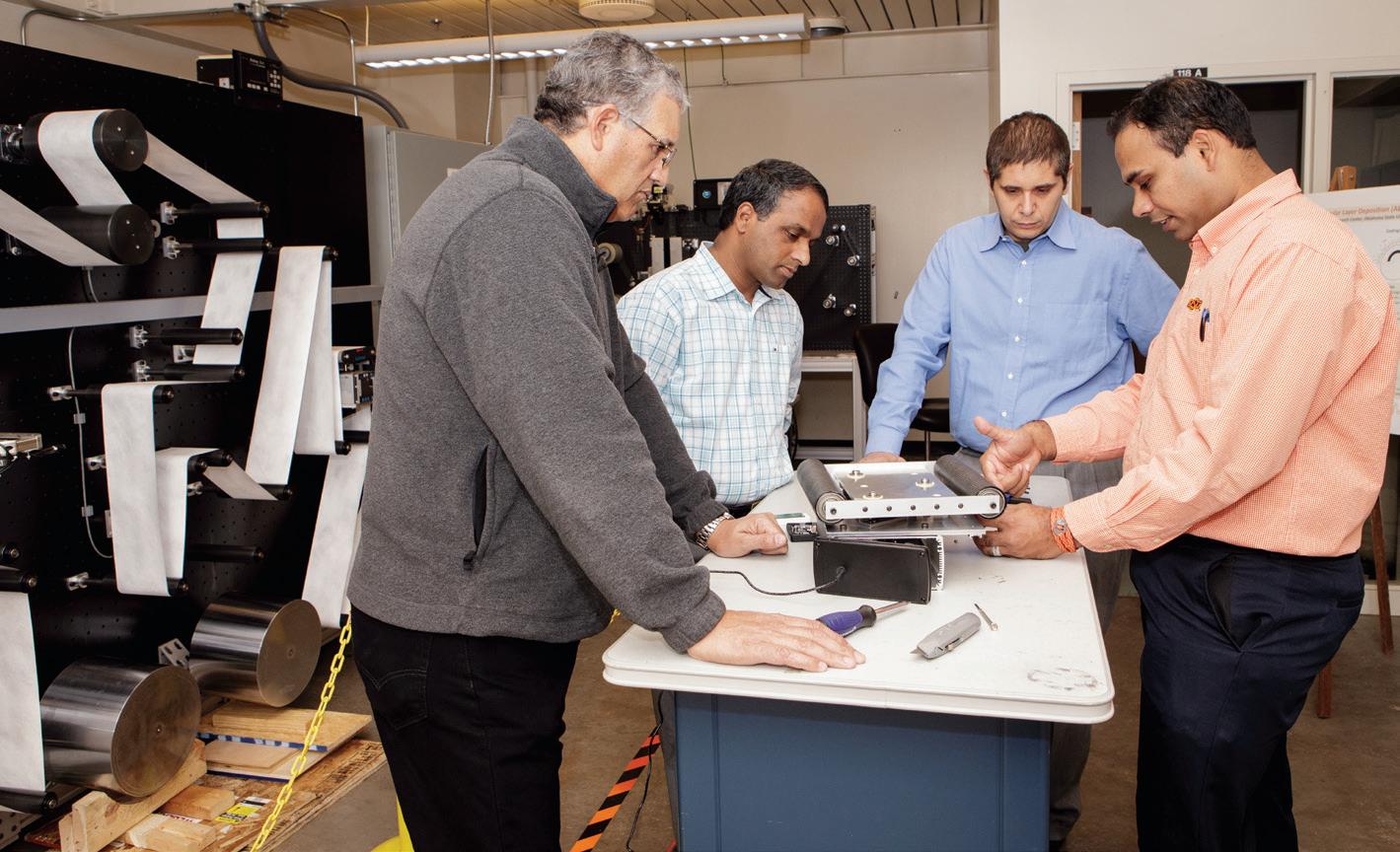
Later, while working on his doctorate, Seshadri enrolled in a class on entrepreneurship for engineers and scientists offered by the School of Entrepreneurship at the Spears School, where he learned the basics of developing a viable business plan for a technology startup.
“I took the class out of curiosity,” Seshadri says. “I’m an engineer. I didn’t know anything about business, but I’ve always been curious to try new things.”
In 2011, Seshadri was accepted into the Creativity, Innovation, and Entrepreneurship (CIE) Scholars Program at the Riata Center, joining a team assigned to develop a business plan to commercialize the fiber optic sensor technology developed by Pagilla and his students. Though it was a good learning experience, the team decided that a business making and selling the sensor wasn’t likely to succeed.
“Our plan was to sell just the sensor, but we realized we would have to sell our sensor to somebody who makes the lateral guiding system,” says Seshadri, “but there’s no incentive for them to use our sensor over another. We hadn’t
“We’ve been working on this for almost 10 years. This has been evolutionary, not revolutionary.”
—Prabhakar Pagilla
developed a good value proposition for the customer to use our sensor.”
Seshadri and his team realized that the sensor’s enhanced technology wasn’t enough.
“The technology by itself is not sufficient,” Seshadri says. “What also matters is the customer’s problem that you’re trying to solve with that technology.”
Engineers and scientists often develop great technology with a general idea of how it may benefit an industry. They then dive deep on perfecting that technology, according to Daniel Will, executive director of Cowboy Technologies, an OSU-owned company that helps university faculty and students in commercializing university technology through startup companies.
“If the voice of end-customers and decision makers is not well understood, that perfection process is for naught,”
Will says. “Aravind came to deeply understand his target customers’ needs to help refine his technology-based solution with a strong value proposition.”
The entrepreneurial seed had been planted, and Seshadri and Pagilla continued improving the sensor while developing a business model based on the entire lateral guiding system rather than just a part of it.
Seshadri put together a new team, including Pagilla and fellow OSU graduate students Pedro Velasco and Carlo Branca, to develop a new business plan for a venture based on a product platform built around the lateral guide system. That team became the founders of Roll-2-Roll Technologies. In 2013, the team entered the statewide Donald W. Reynold’s Governor’s Cup business plan competition, finishing second in their division. That win qualified
PHOTOS / GARY LAWSON
15 Research at Oklahoma State University • www.vpr.okstate.edu
The founders of Roll-2-Roll Technologies receive an update on the development of a lateral guide prototype. The startups’ founders include (from left) Pedro Velasco, Prabhakar Pagilla, Carlo Branca and Aravind Seshadri.
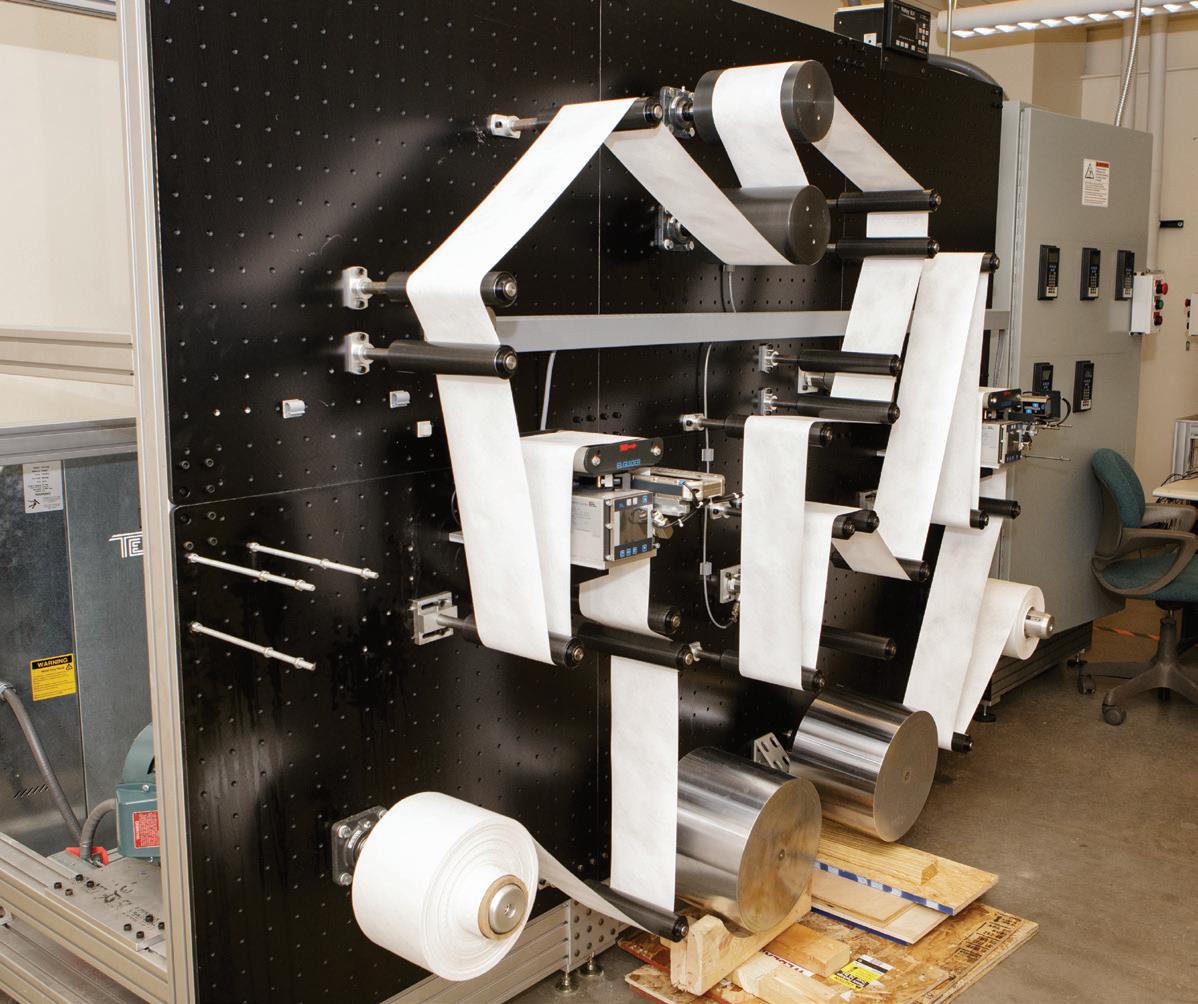
“We didn’t have the flashiest presentations, but we had knowledge of the industry and how we were going to solve problems for our customers.”
—Aravind Seshadri
the Roll-2-Roll Technologies team to enter the regional Reynold’s Tri-State business plan competition, which they won. The team also won the OSU Riata Business Plan Competition.
“We didn’t have the flashiest presentations, but we had knowledge of the industry and how we were going to solve problems for our customers,” says Seshadri. “The competitions reinforced our belief that this was going to work.”
The wins opened doors and provided them with initial funding. The Roll-2-Roll team won $10,000 in prize money from the Governor’s Cup, $30,000 from the Tri-State competition and $25,000 from the Riata competition. The wins also introduced Seshadri to i2E, an Oklahoma nonprofit that mentors tech startups and receives funding from the state’s Oklahoma Center for the Advancement of Science and Technology (OCAST). The Roll2-Roll founders further refined
their business model in the 10-week i2E Proof of Concept program.
As part of the program, Seshadri and his partners contacted more than 100 potential customers, quizzing them on their needs to make sure the lateral guide technology is actually needed in the real world. Seshadri talked with an Italian company that is one of the world’s largest manufacturers of roll-to-roll diaper machines. The experience was eye-opening.
“Most manufacturers don’t develop their own technologies. They rely on others to provide them with technology,” Seshadri says. “I realized that this is an opportunity for us.”
Seshadri wants Roll-2Roll to become the company providing technology solutions to roll-to-roll manufacturers.
“Our company is called Roll-2-Roll Technologies. It isn’t called the lateral guide company because we want to be
Research at Oklahoma State University • www.vpr.okstate.edu 16
Much of the technology developed by the Roll-2-Roll Technologies team was built and tested at the OSU Web Handling Research Center. The center is a university/industry partnership created to improve manufacturing systems that use rolled materials such as paper.
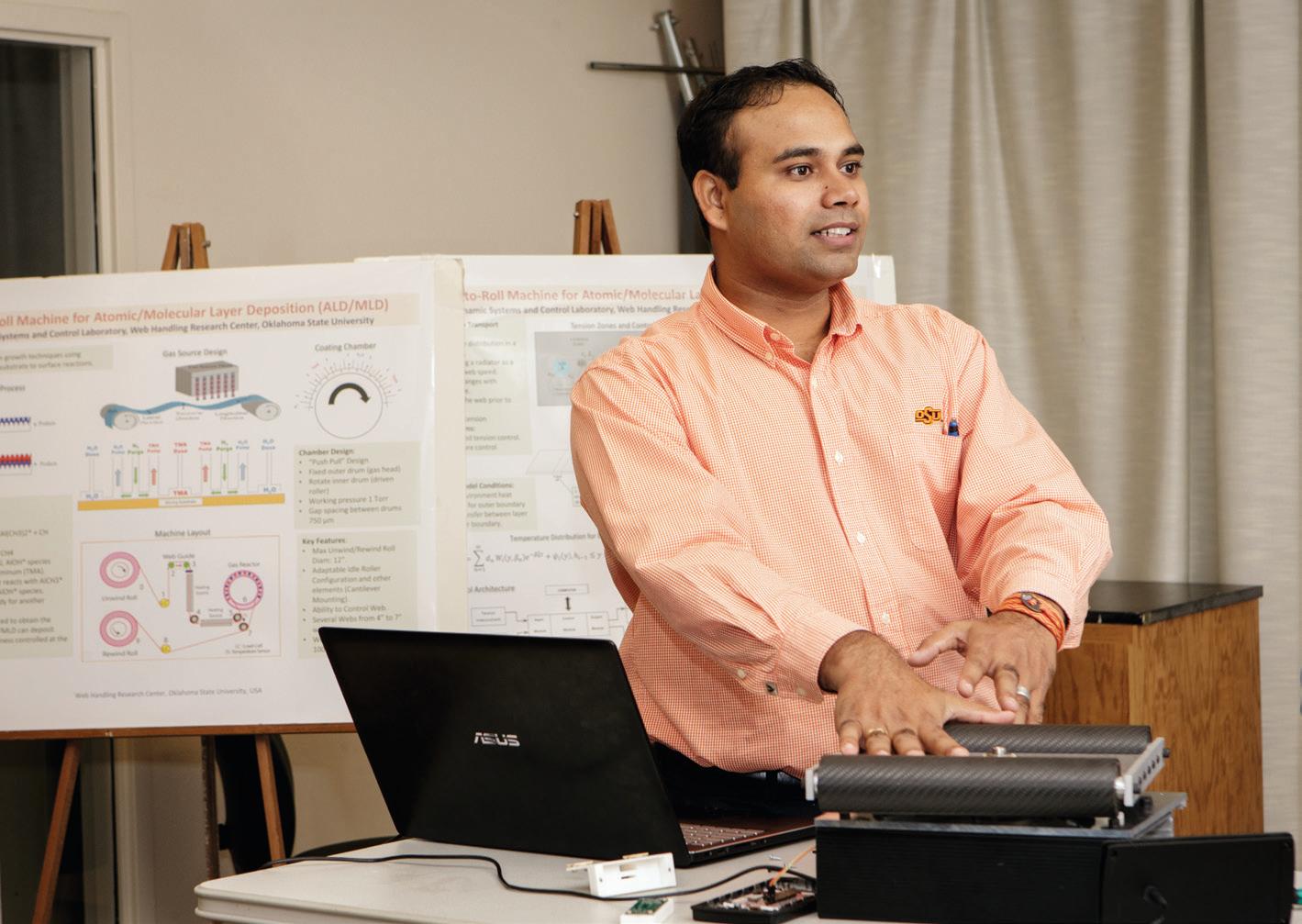
in the business of providing intelligence for roll-to-roll machines,” Seshadri said. “The device itself, we’ll have someone make for us, but we’ll focus on the secret sauce, the algorithm that controls it.”
In parallel to the refinement of the business plan, Pagilla and Seshadri needed to fund Seshadri as an OSU postdoc to develop a full lateral guide proof of concept prototype. They turned to OSU’s Technology Development Center’s Technology Business Development Program, which provides OSU faculty with internal grants for university technology with commercial potential to advance them to the point of licensing. The TDC is also responsible for OSU intellectual property protection and licensing to companies. The TDC licensed the applicable OSU technologies to Roll-2-Roll Technologies.
With confidence building in the first proof of concept prototype and a sound business plan in place, Roll-
2-Roll raised more than $520,000 of seed investment in July from Cowboy Technologies, i2E and a group of “angel” investors, individuals who provide investment capital for startups. The company founders also contributed their own money. In August, OCAST awarded Roll-2-Roll a two-year grant of nearly $300,000 that will continue to fund its technology development.
Seshadri and his co-founders incorporated Roll-2-Roll in 2013. Today, Seshadri is still the company’s only fulltime employee, though other founders will soon come on as employees. He is busy developing and testing prototypes, working with suppliers and networking with prospective customers. The goal is to have the company’s prototype ready for a customer evaluation early in 2015.
Will says Roll-2-Roll Technologies continues to be on the right track. Seshadri possesses the right entrepreneurial, customer-first
mindset and is fully utilizing OSU’s unique technology. He has also done an excellent job of leveraging OSU’s entrepreneurial resources to incubate technology, Will says.
“We are working to build an ecosystem of entrepreneurship through innovation at OSU,” says Will. “Cowboy Technologies, the Technology Development Center and the Spears School of Business are significant resources available to OSU students and faculty who have the ideas and the persistence to commercialize technology through successful startup businesses.”V
JEFF JOINER
17 Research at Oklahoma State University • www.vpr.okstate.edu
Roll-2-Roll Technologies CEO Aravind Seshadri explains the latest improvements he has made to the company’s lateral guide for roll-to-roll manufacturing machines.
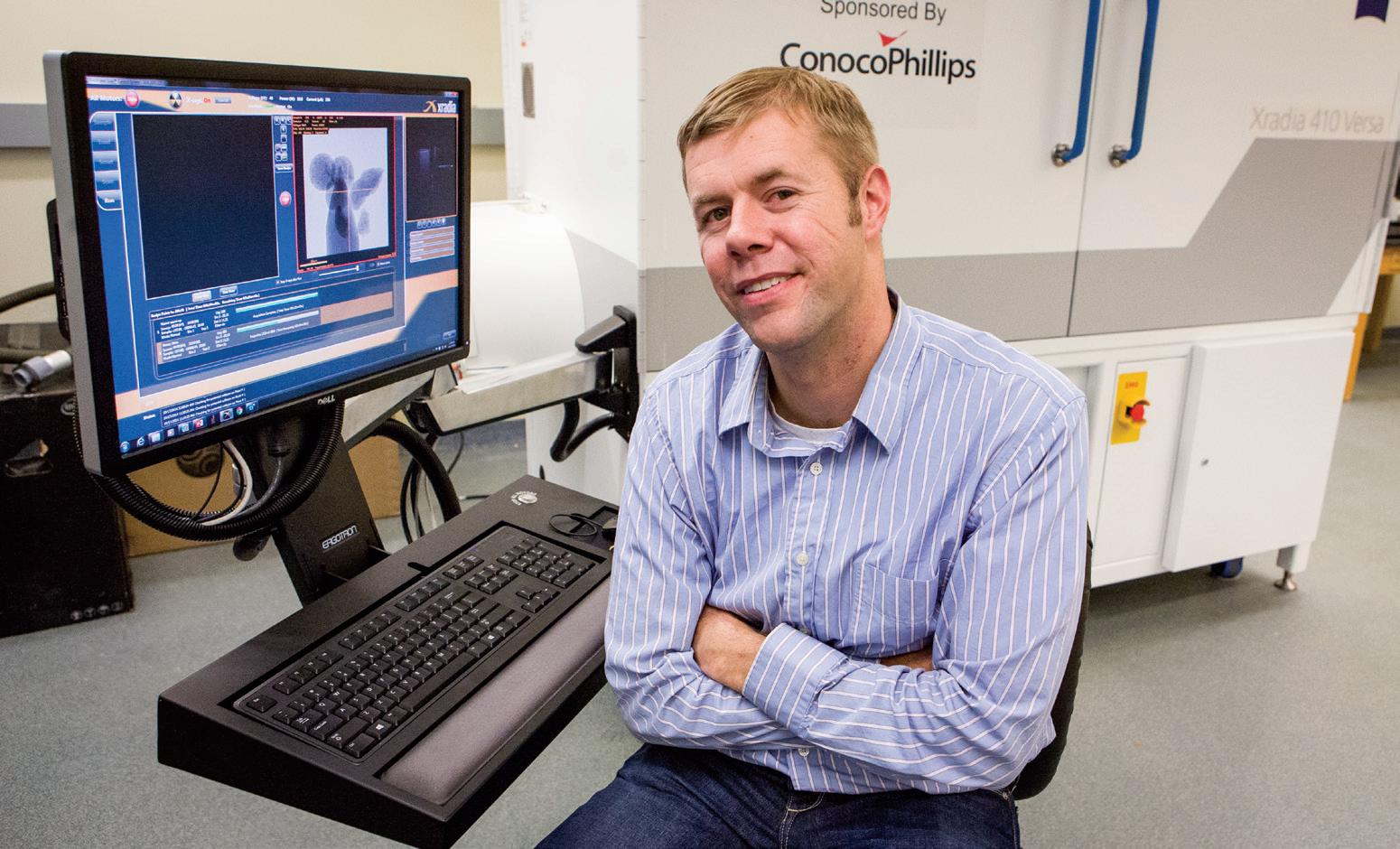
CONCRETE STUDIES
Tyler Ley’s work leads to new world for building material
Concrete is the second mostused commodity in the world, topped only by one of its primary components — water. At five cents per pound, concrete is the most inexpensive, longest-lasting material on the planet.
For seven years, Tyler Ley, OSU associate professor and Williams Foundation professor of civil and environmental engineering, has performed world-class concrete research and implemented practical uses of his findings in Oklahoma and surrounding states. His efforts have led to the creation of equipment and establishment of nationwide standards.
Ley and his research team lead a variety of projects united by the theme of improving concrete. From 3-D images of
components interacting to new concrete mixtures currently used in Texas, Ley and his colleagues are changing the future of this diverse material.
Nanoscale perspective
Ley’s lab is one of a few that can view materials at the nano scale, showing 3-D images where each point is 30 nanometers in size, and a sample is 1/5 the size of a hair. This gives the research team the ability to see how the cement particles in concrete react and form their internal structure.
Ley says control of the microstructure allows for the control of large-scale properties, an elemental piece of his goal to alter the basics of concrete to improve its ability
to withstand stress and reduce its CO2 emissions during production.
Through a partnership with Princeton University, the University of California in Santa Barbara, the University of Bremen and the National Institute of Standards and Technology (NIST), Ley’s research team is imaging the reaction of cement by producing three-dimensional structure and chemistry images of their results for use in models created at Princeton and NIST. The work is being done at the Center for Nano Materials at Argonne National Laboratory, just outside Chicago. The goal is to provide computer models for engineers to better predict the reaction and innovative changes to concrete on a global scale.
Civil and environmental engineering professor Tyler Ley has built a lab at OSU that is changing the future of concrete, one of the most durable and affordable building materials in the world.
Research at Oklahoma State University • www.vpr.okstate.edu 18
PHOTOS / GARY LAWSON
“If we could find simple ways to improve the cost, carbon footprint or durability of concrete, the benefits to society would be huge,” says Ley. “Successfully making tweaks to the basics of cement has the potential for multibillion-dollar savings.”
While Ley’s team is making significant headway in these areas, he has already brought several research projects to fruition through implementation.
Impactful results
Ley’s work has changed the landscape for concrete and concreterelated issues in Oklahoma and several other states. Together with partnerships within the College of Engineering, Architecture and Technology and others throughout OSU, Ley has developed new concrete mixtures and testing standards used internationally.
Applied research from Ley’s lab can be found in roadways, bridges and concrete structures across Oklahoma and Texas. Most recently, Ley’s team designed a new concrete mixture that recognizes rock sizes, allowing companies to save on the cement used while producing concrete. Savings from this development are moderately estimated at $4 million per year in total cost and 400 homes’ worth of energy.
Another of Ley’s inventions to streamline the concrete industry is the Super Air Meter (SAM). The device detects the size distribution of bubbles in a concrete mixture before it has hardened. This gives producers time to adjust the mixture before pouring.
Ley says soap is added to concrete because small bubbles are necessary to create space for water as it freezes due to outside elements, citing what happens to a soda in a freezer as a demonstration of what freezing temperatures can do to concrete that does not have the correct size air bubbles.
The SAM is used in 16 states, and 12 of those are currently
funding further research, including a partnership between Purdue University and OSU to investigate new specifications. The results of this project have already led to a pending American Association of State Highway and Transportation Officials (ASHTO) test method that, if instituted, will alter concrete processes across the country.
Future generations
Whether teaching in the classroom or leading projects in a lab, Ley is a role model and innovative leader in his field and on campus. Several graduate students work alongside him, and his passion makes a meaningful impact on those around him, from inspiring
students to pursue the area to including them in important research findings.
Doctoral candidate Marllon Cook comes from a long line of concrete contractors. He came to OSU ready to study anything but the same line of work he grew up around, but after a class with Ley, Cook soon found himself in classrooms and labs learning and researching concrete.
“Dr. Ley has built a highproductivity research environment that allows the research assistants to learn cutting-edge technology in the industry,” says Cook. “He makes his students not only think outside the box, but question the box’s own existence.”
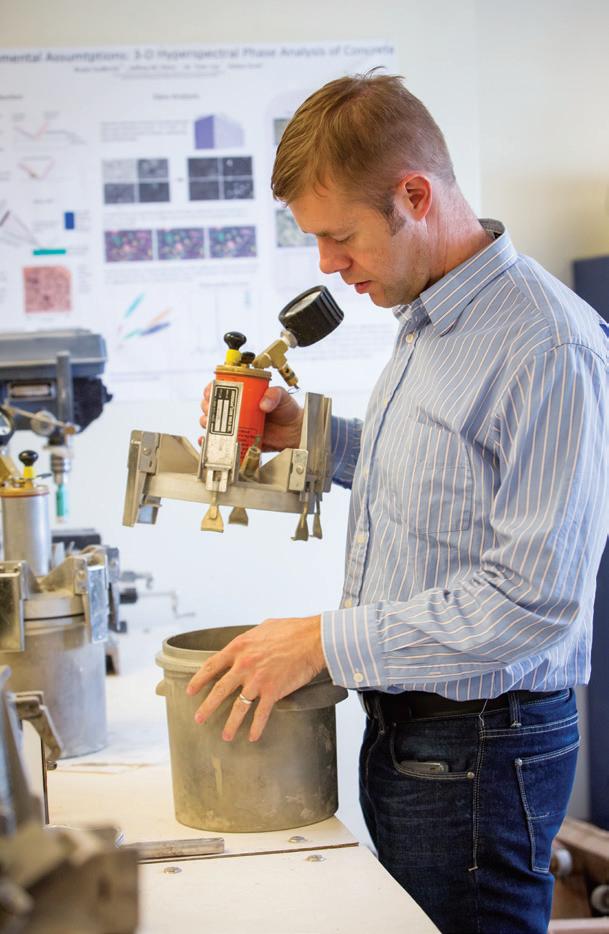
Once Ley has students as passionate about concrete as he is, he fosters the learning atmosphere through mentorship.
Second-year graduate student David Welchel says Ley provides guidance for any problems and has taught him a great deal. Welchel has been a part of the new testing standards soon to be implemented and will use his experience as he pursues his career.
Whether standing on a back patio or driving across a bridge, one can find Ley’s work reflected in countless places. His research is taking concrete into the future and improving processes while encouraging the next generation of concrete researchers and industry professionals to see the field’s importance. Ley is changing the future of concrete, the lives of students and the partnerships of OSU. V
CHELSEA ROBINSON
“Dr. Ley has built a high-productivity research environment that allows the research assistants to learn cutting-edge technology in the industry.”
—Marllon Cook
19 Research at Oklahoma State University • www.vpr.okstate.edu
Applications of Ley’s research can be found in highways, bridges and other concrete structures across Oklahoma and Texas.
CHILDREN & FAMILIES AT RISK STUDYING THE LIVES OF
Researcher charts children’s development during life’s transitions
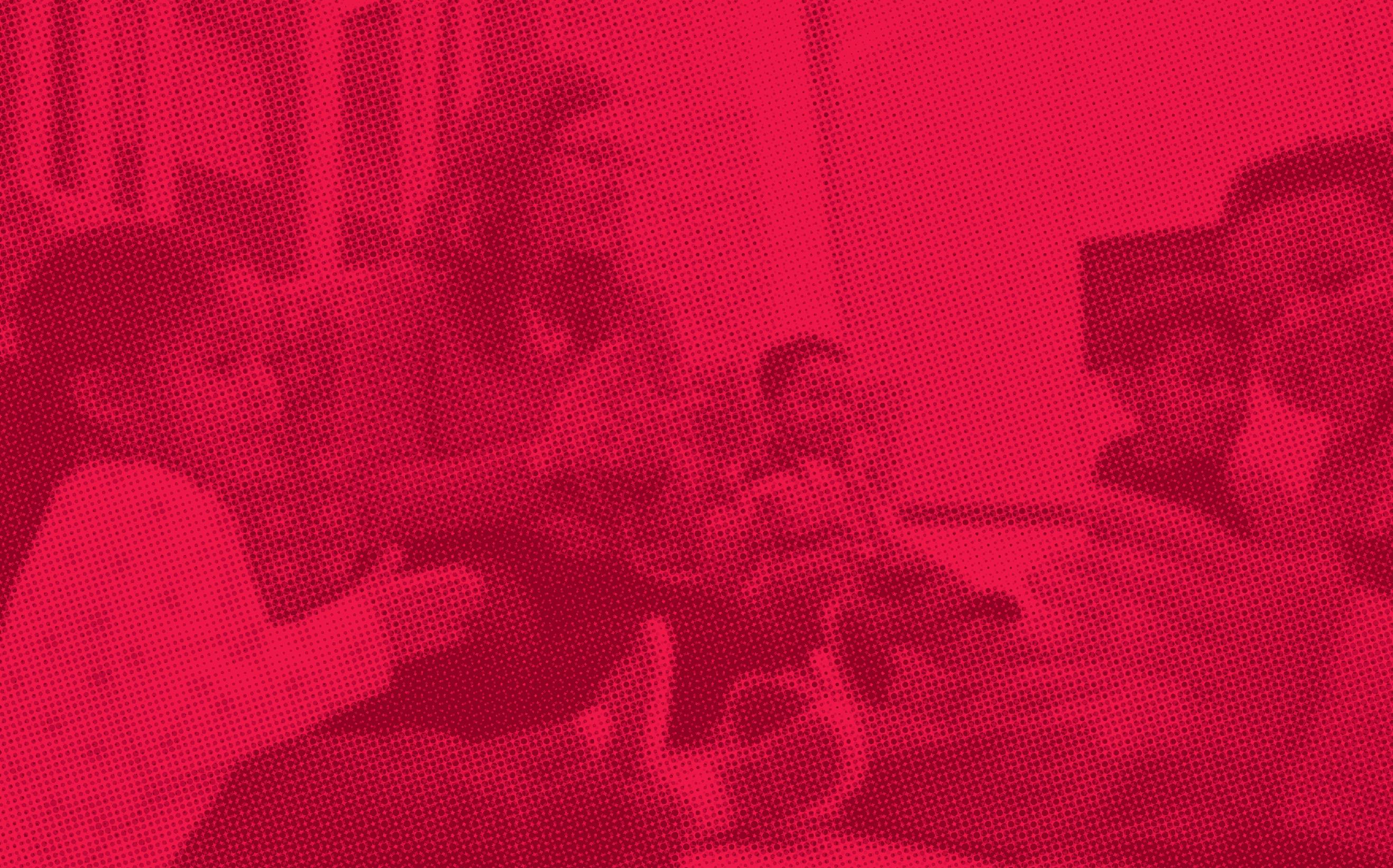
Abe understood in order to affect the success of children from the early years through their young adult lives. She has had an interest in emotional development and the factors that affect adjustment and resilience since her undergraduate studies.
As the Bryan Close Endowed Chair in Early Childhood Development in the College of Human Sciences, Morris focuses her research on disadvantaged, high-risk families and children during important transitions in their lives. While much attention has been placed on early education and its role in school readiness, Morris believes young children’s social-emotional development is the key to success and that requires supportive environments in families.
That passion has led Morris to be the principal investigator on six current projects studying the wellbeing of children, youth and their families primarily in the Tulsa area.
expertise for the Community Action Project’s Head Start and Early Head Start Centers, and Tulsa Educare. She is currently studying the effectiveness of dual-generation education programs directed by Tulsa County’s Community Action Project.
CAP’s CareerAdvance® program supports the career development of low-income parents while their preschool children are enrolled in Early Head Start and Head Start centers. The program is the subject of the Family Life Study, which includes implementation, outcomes and impacts.
Led by researchers at the Institute for Policy Research at Northwestern University, the Ray Marshall Center at the University of Texas at Austin, Columbia University and New York University, the study is funded by the U.S. Department of Health and Human Services’ Administration for Children and Families.
focus groups to evaluate the effects of the workforce development program.
“The Family Advancement Study is exciting to me as a researcher because it is a randomized control trial,” Morris says. “It’s a longitudinal study with multiple waves of data collection. We are following families and a comparison group to provide more accurate information on the success of the program.
“We have been able to study the impact of dual-generation parents’ perceptions of their involvement and evaluate the effect of the program on children’s development in such areas as school readiness and socio-emotional development.”
Morris points out the benefits the research projects have for OSU and its faculty.
“OSU has received more than $1.5 million in grants for these projects,” she says. “Research projects
Research at Oklahoma State University • www.vpr.okstate.edu 20
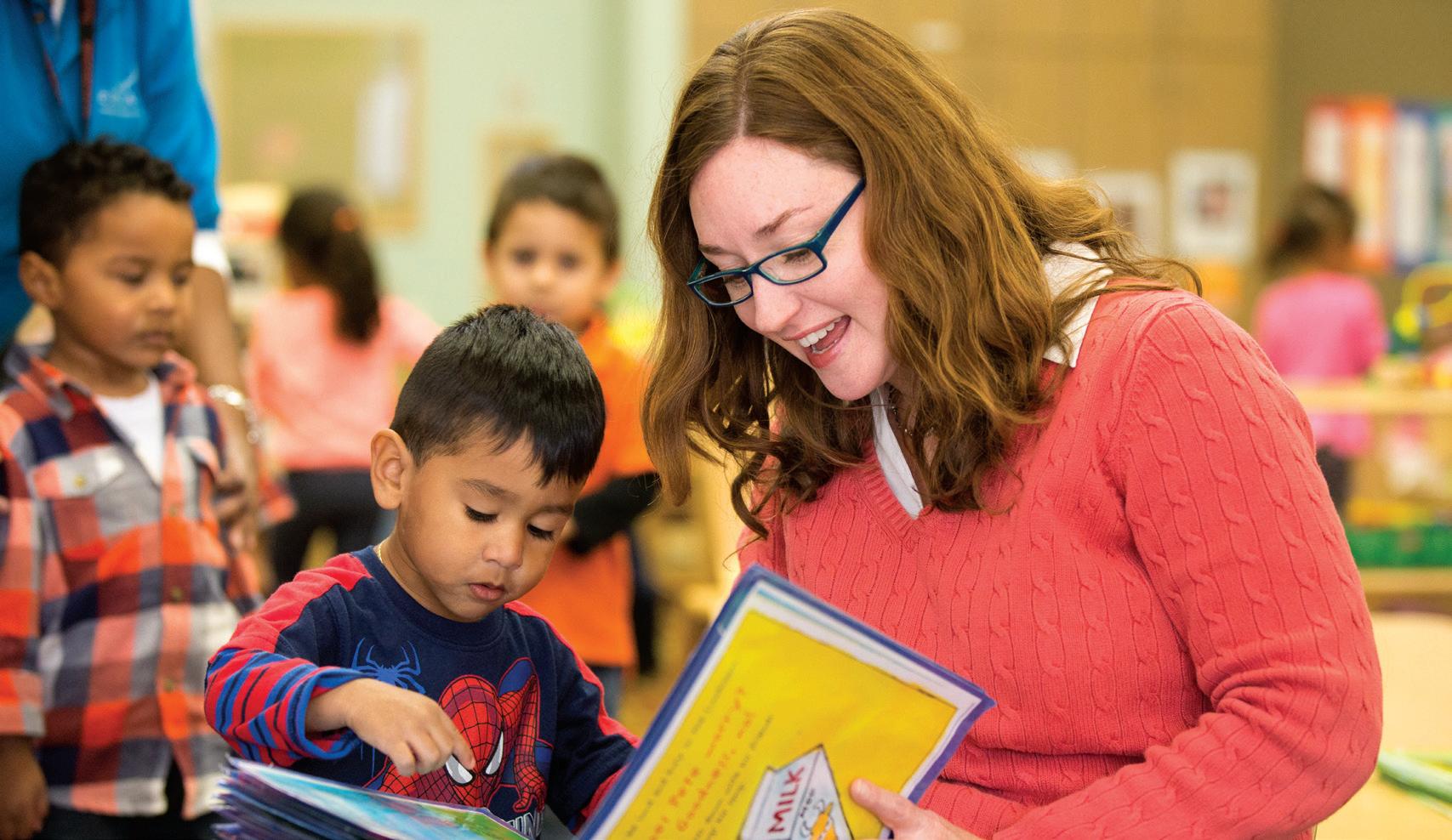
“It is exciting to bring cutting-edge early childhood programs and research to the Tulsa community.”
—Amanda Sheffield Morris
at this level not only provide grant funding and data for publications and presentations, but also opportunities for student training and partnerships with leading researchers in the field.”
Morris is partnering with Jennifer Hays-Grudo and her research team to evaluate the impact of Tulsa Children’s Project programs on children and their parents who attend three Educare Centers in Tulsa.
Working to break the cycle of poverty, Educare provides high-quality early childhood education and care to low-income families. Several projects aim to improve mental health among parents and staff at the three sites.
“Parent and teacher relationships are important predictors of children’s overall adjustment, with more supportive and less coercive adult-child relationships being more beneficial,” Morris says.
“The Super Parents Program, led by the Tulsa Children’s Project, improves parenting through mindfulness training, stress management, and basic parenting skills,” Morris says. “Our research will evaluate the training and impact of positive parenting on the families.”
With funding provided by the George Kaiser Family Foundation and the Centers for Disease Control and Prevention, Morris is looking forward to evaluating new TCP initiatives.
One is a training program for caregivers of infants and young children up to 24 months known as Attachment and Bio-behavioral Catch-up (ABC) Intervention. Trained staff conduct home visits over 10 weeks teaching caregivers how to respond to children and develop appropriate nurturing skills.
“We are looking forward to working on ABC to see how well it works with high-risk families,” Morris says.
Morris will also study the effectiveness of Legacy for Children™, a parenting group for pregnant moms developed by the Centers for Disease Control and Prevention.
“Legacy is a three-year program focused on responsive parenting while building a social-support system for moms,” Morris says.
“It is exciting to bring cuttingedge early childhood programs and research to the Tulsa community,” says Morris. “Partnering with community agencies allows us to evaluate the impact of these programs on a large scale, with the goal to take such programs beyond Tulsa to the broader Oklahoma and national community.” V
JULIE BARNARD
Amanda Sheffield Morris, a professor of human development, works with children and their families in Tulsa as part of research into the social and emotional development of children and the role of parenting.
21 Research at Oklahoma State University • www.vpr.okstate.edu
PHOTOS / GARY LAWSON
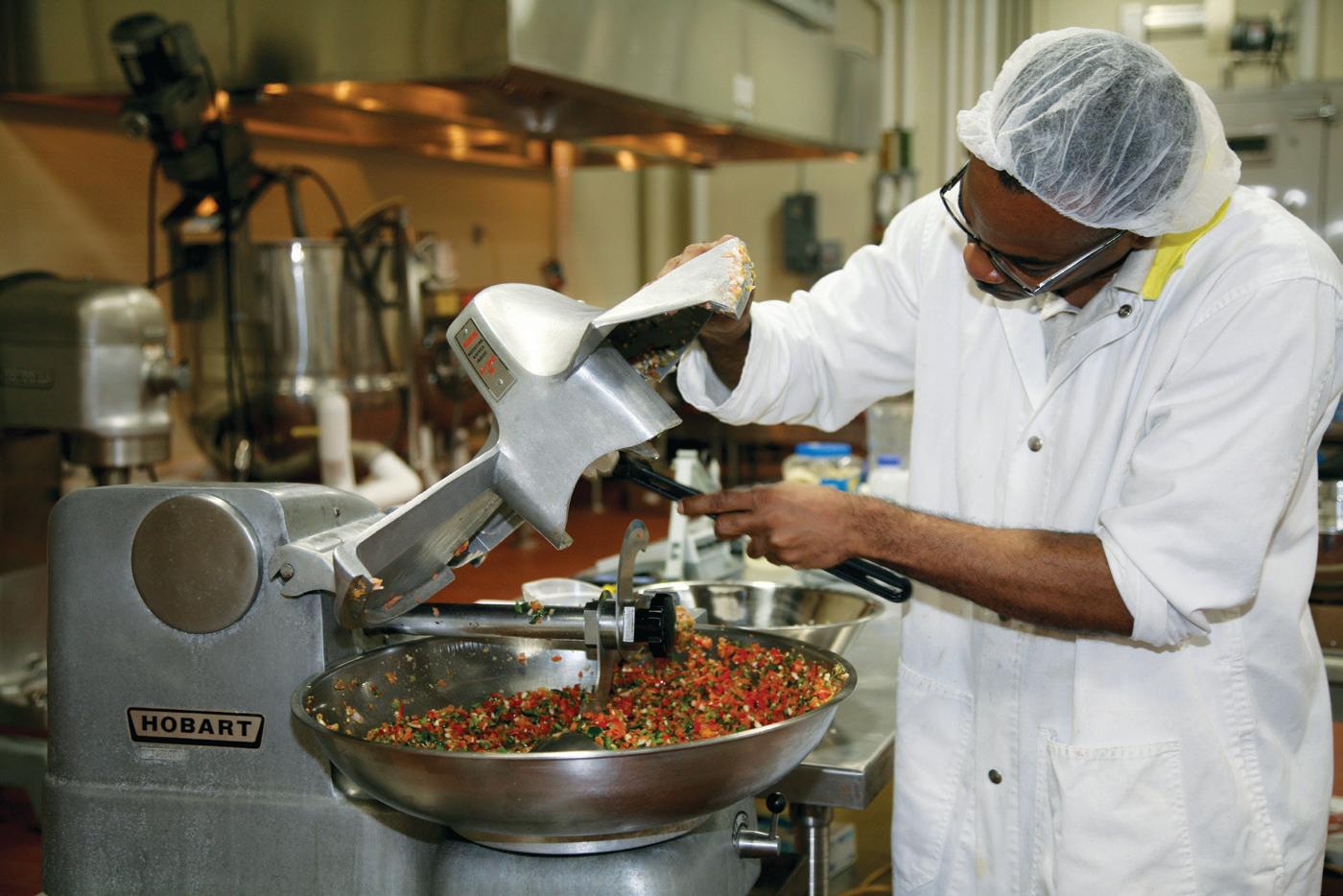
From to
MARKET SCRATCH
Commercializing a Food Product
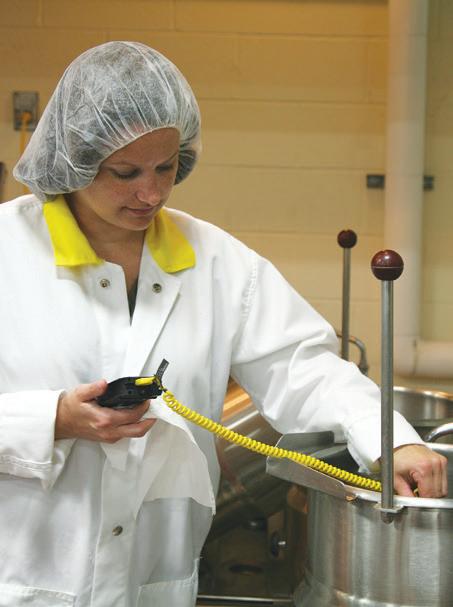
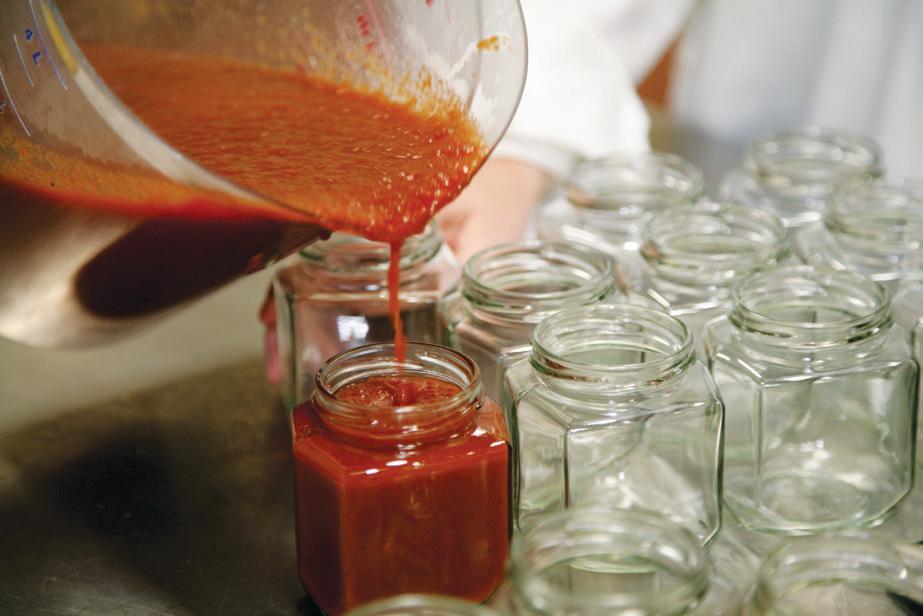 OSU’s Robert M. Kerr Food & Agricultural Products Center offers assistance to entrepreneurs who are interested in starting their own food businesses. (Top) Darren Scott, FAPC food scientist and sensory specialist, uses a bowl chopper in the making of homemade salsa.
(Bottom) Erin Johnson, FAPC business and marketing client coordinator, checks the temperature of a food product before pouring into jars.
OSU’s Robert M. Kerr Food & Agricultural Products Center offers assistance to entrepreneurs who are interested in starting their own food businesses. (Top) Darren Scott, FAPC food scientist and sensory specialist, uses a bowl chopper in the making of homemade salsa.
(Bottom) Erin Johnson, FAPC business and marketing client coordinator, checks the temperature of a food product before pouring into jars.
Research at Oklahoma State University • www.vpr.okstate.edu 22
PHOTOS/
MANDY GROSS
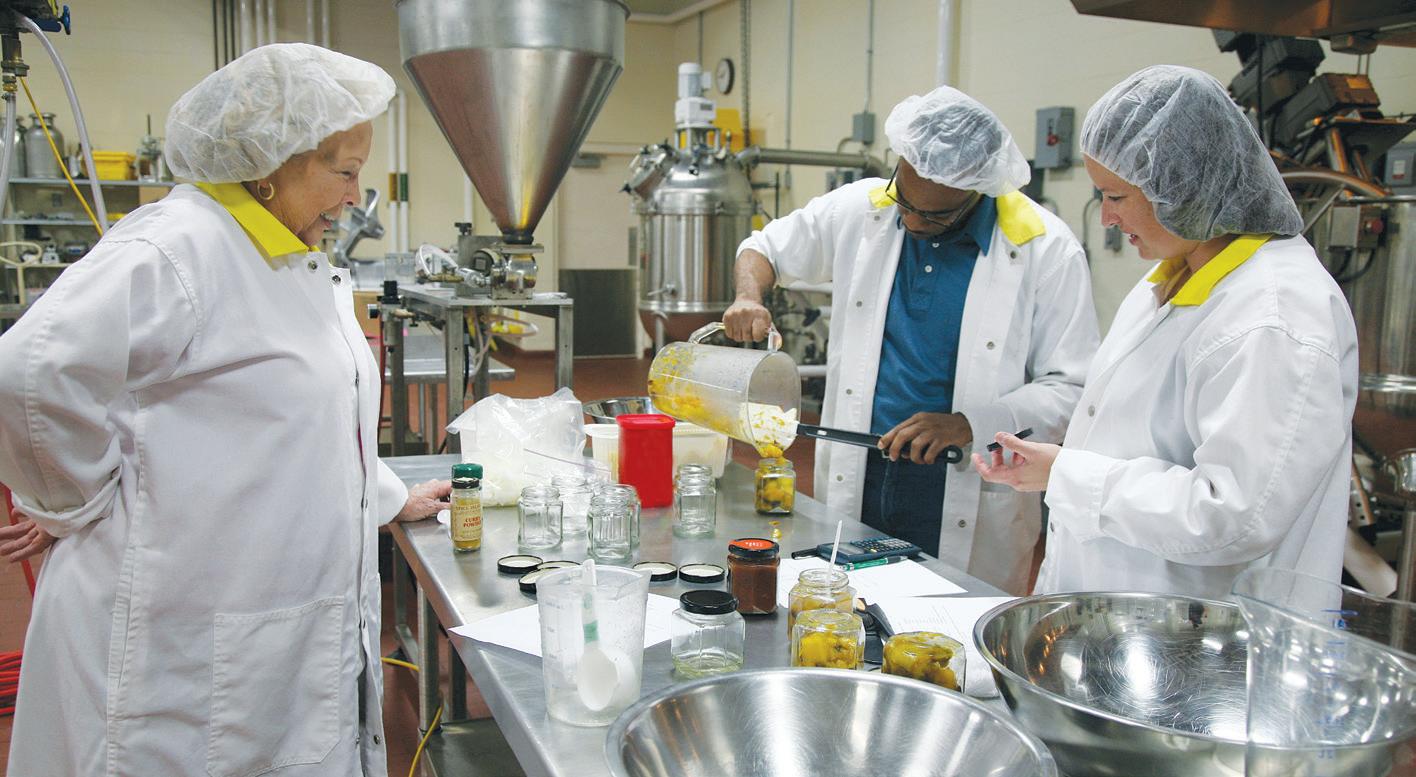
Your friends tell you your salsa is the best they’ve ever tasted.
Your mother has been serving her “world’s best” homemade jelly for years. Your grandmother’s pasta sauce is the hit of every family gathering. You think about selling your food product, but you don’t know where to begin.
Oklahoma State University’s Robert M. Kerr Food & Agricultural Products Center has food scientists who specialize in helping entrepreneurs commercialize homemade recipes.
Scaling Up Food Recipes
Erin Johnson, FAPC business and marketing client coordinator, says clients often contact the center with a recipe created in a home kitchen.
“The clients’ goal is to produce their product on a mass scale, but some clients do not know the steps to produce a product for market,” she says.
The recipe scale-up process is a component of FAPC’s Client Success Path, a five-step program for entrepreneurs to take a product to market.
“Depending on the product, scale-up can be completed in about six hours in one visit to the center,” Johnson says. “FAPC completes approximately
10 recipe scale-ups per year for a variety of different food products, the most popular being jams, jellies, sauces, salsas and condiments.”
Darren Scott, FAPC food scientist and sensory specialist, says there are three steps in scaling up product recipes, starting with a satisfactory product.
Starting Out
The first step is converting units used at home to typical industry-size units. Scott says it is easier to work with industry units when measuring large amounts of ingredients.
FAPC takes the dashes, pinches and cups and converts them to pounds, grams or gallons. The ingredients also are converted to percentages for the distribution process.
“The reason using percentages is important is because you cannot measure 98 tablespoons for a larger batch,” Johnson says. “You will eventually lose count of the number of tablespoons needed.”
Once FAPC gives the clients the percentages of ingredients within their product, the client will typically take the percentages to a contract packager, or co-packer, to scale up their recipe for distribution.
“FAPC completes approximately 10 recipe scale-ups per year for a variety of different food products.”
—Erin Johnson
23 Research at Oklahoma State University • www.vpr.okstate.edu
FAPC’s Darren Scott (middle) and Erin Johnson (right) help Suan Grant of Suan’s Foods in Oklahoma City with product development of one of her food products. Suan’s Foods offers a line of scotch bonnet pepper-based condiments.
Keeping Food Safe
With a growing demand for safe, quality food products, the need for food industry companies to engage in food-safety programs is more important than ever.
Oklahoma State University’s Robert M. Kerr Food & Agricultural Products Center understands the importance of food safety and has launched a $3.4 million fundraising goal to create a food-safety program at OSU and assist food companies with their food-safety needs.
FAPC’s Industry Advisory Committee provided more than $1 million as a lead gift in this food-safety campaign. In addition, with the support of the advisory board, FAPC implemented a Global Food Safety Initiative program to strive for continuous improvement of food-safety management systems that ensure safe food and consumer confidence.
Food safety is the responsibility of all members of the foodsupply chain from the farmer to the manufacturer to the distributor that delivers the product to the stores.
OSU’s food-safety program will serve all sectors of the food industry from production agriculture to wholesale and retail distribution channels. Ingredient, packaging and equipment suppliers also are affected by food-safety issues, as are regulatory entities.
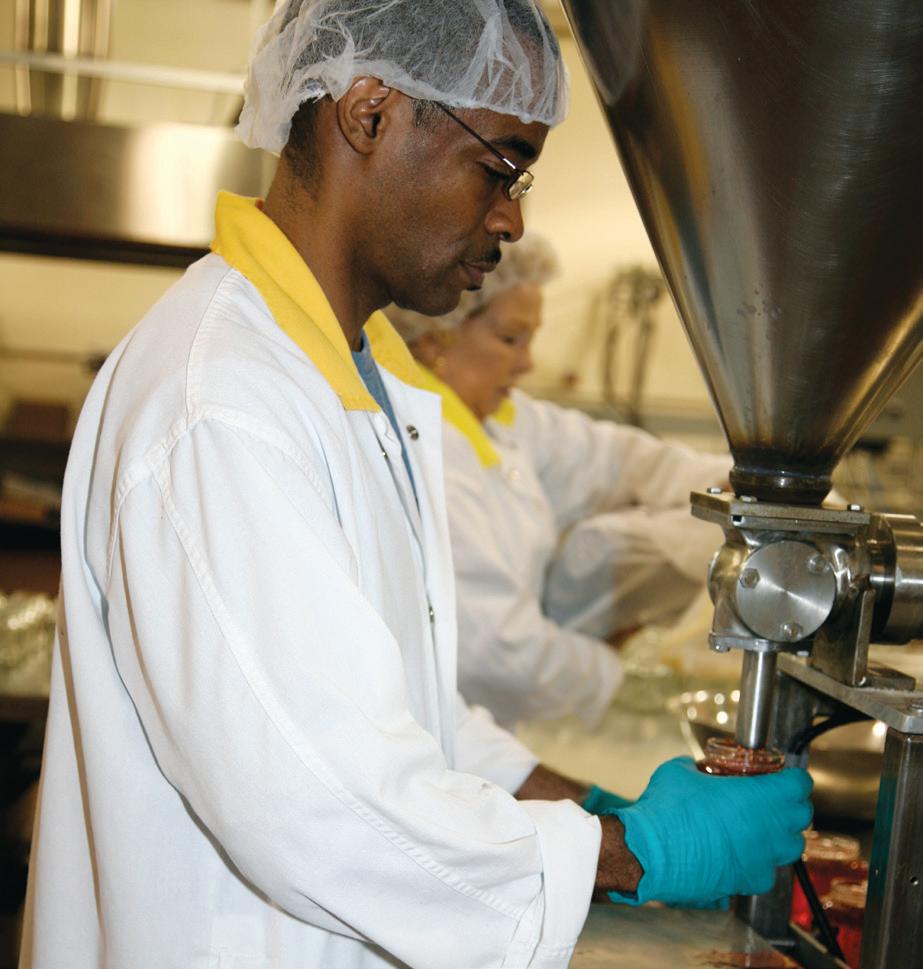
FAPC recommends clients conduct research before picking a co-packer.
“Co-packers can be selected by reviewing their cost of services, production records and experiences with similar products,” Scott says. “FAPC provides the client a list of question that can be used to interview co-packers.”
Scaling up a recipe is also about the business side of production.
“Many producers come to FAPC for assistance and do not realize their production costs,” Johnson says. “Initially, they will often purchase home-style ingredients for their product at retail cost, then switch their ingredients for a cheaper alternative to lower production costs.”
In some cases, ingredients with specific functionality may replace their home-style ingredients in scaled-up batches. An example of a cheaper alternative is to replace a thickening agent purchased at the store for a commercial batch starch.
Finding Changes
The next step in the scale-up process is observing the batch and noting any changes versus the original recipe.
“Obviously, this is done because the original recipe is the target,” Scott says. “Sometimes it is possible to predict what changes may occur in a scaled-up recipe, but often that is not the case.”
When scaling-up a recipe, the ingredients sometimes react differently on a larger scale.
“Scaled-up batches of a product may be very different from the original formula because of differences in taste, texture, aroma or appearance,” Scott says. “Foods are a complex system of interacting physical and chemical properties. When the product is scaled up, the function of these properties changes.”
The scaled-up products often receive a higher degree of scrutiny compared with home-style products, Scott says. The scaled-up batch makes observing “flaws” easier,
FAPC’s Darren Scott uses a bottle filler to fill jars for a food entrepreneur during the scale-up process.
Research at Oklahoma State University • www.vpr.okstate.edu 24
FAPC’s Darren Scott uses a bottle filler to fill jars for a food entrepreneur during the scale-up process.
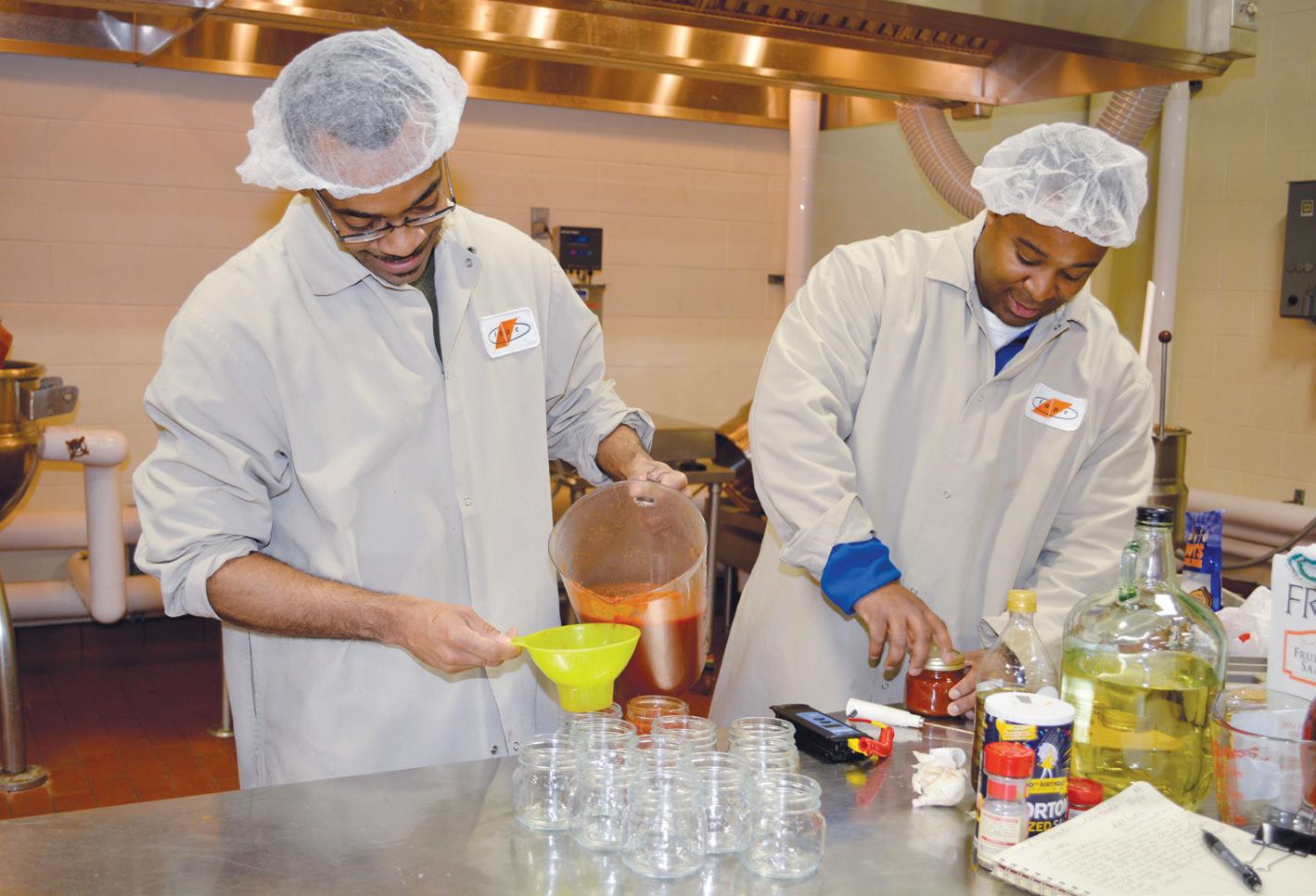
even though they may have already existed in the small batch.
“It should be noted that many times the scaled-up batches are often no better or worse than the original,” Scott says. “They are just different.”
However, some ingredients are more difficult to scale up than others. An example is mixing spices with lightercolored ingredients in large quantities. The colors may run or bleed together.
Fruits and vegetables may be difficult, as well. Scott says it is important to consider whether the fruit and vegetable commodities need to be peeled, cored or seeded when scaling-up the recipe.
“The client will sometimes change the ingredients so the product will
work well on a larger scale,” Johnson says. “It is a trial and error experience. In some cases, it might not be possible to make the scaled-up batch identical to the original small batch.”
The final step in scaling-up a recipe is adjusting the scaled-up recipe.
“The ultimate goal is making the subsequent batches of the recipe closely match the original recipe,” Scott says. “This may involve changes in the ingredients, changes in the equipment used to make the recipe or both.”
Final Formulation
FAPC is dedicated to helping entrepreneurs succeed in producing their product.
In addition to product scale-up,
FAPC offers a variety of resources and workshops to assist food entrepreneurs in creating a product.
Basic Training class, for example, helps food entrepreneurs address business planning assistance and strategies, market identification and food-processing regulations.
“The food product scale-up is an exciting and challenging process that requires an organized, flexible and consistent approach for success,” Scott says. “Success is often achieved when a recipe and process for commercial production is accomplished and is ultimately measured in terms of the food product’s profitability and customer satisfaction.” V
LACI JONES
“Scaled-up batches of a product may be very different from the original formula because of differences in taste, texture, aroma or appearance.”
—Darren Scott
25 Research at Oklahoma State University • www.vpr.okstate.edu
FAPC’s Darren Scott (left) fills jars of product for Corey Carolina (right) of Carolina Food Co. The Tulsa-based food company offers a line of Toasted wine fruit spreads.
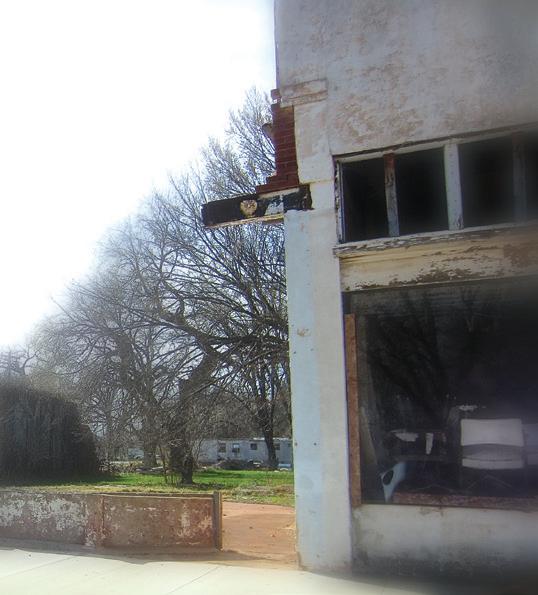
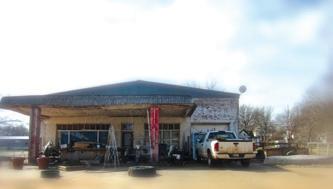
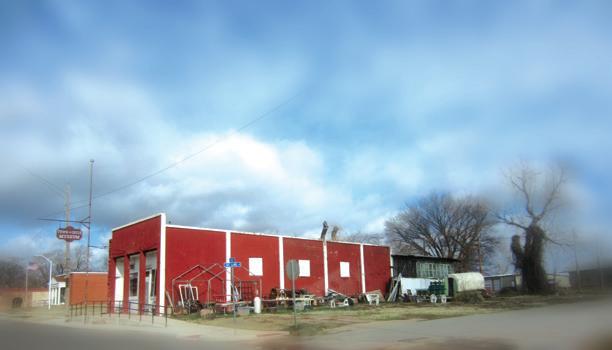

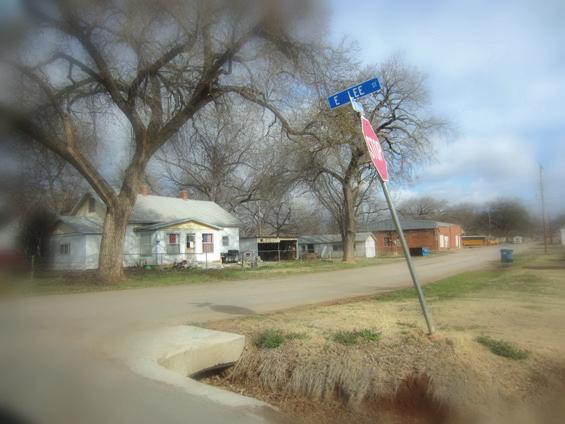
The new ‘Building Resilient Communities’ project, developed in the OSU College of Education, is working to make a significant and lasting impact on a local community while creating a blueprint for future partnerships.
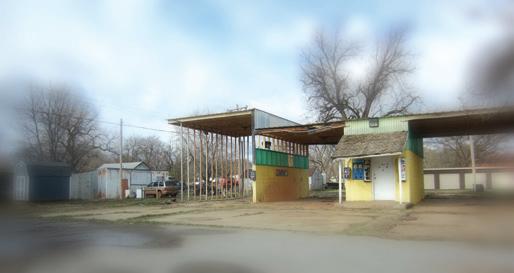
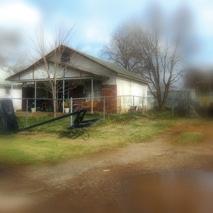
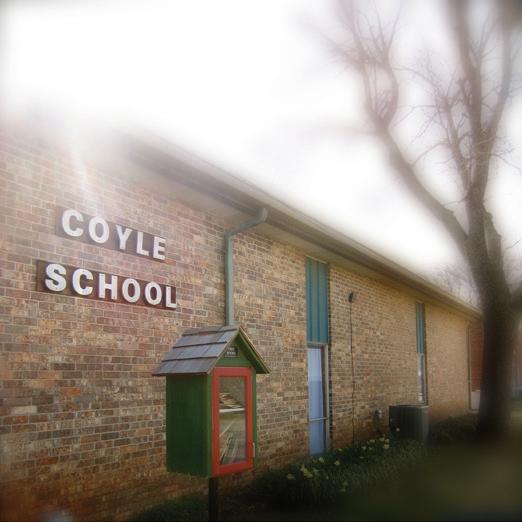

Raising Quality of Life
Through Community Partnerships
An interdisciplinary team of OSU faculty and graduate students is working with community groups in Coyle to bring resources to the town to improve its school system and the quality of life of its residents.
PHOTOS PROVIDED Research at Oklahoma State University • www.vpr.okstate.edu 26
From Concept to Reality
“I had the idea to leverage the resources and expertise of faculty and students at OSU to help a highpoverty community addresses its challenges,” says counseling psychology professor John Romans.
Romans approached faculty colleagues Hugh Crethar (counseling) and Julie Croff (health education and promotion) about a pilot project. Fae Frederick, a doctoral student in the counseling psychology program, and Tonya Hammer, another counseling faculty, joined the group.
School administration professor Ed Harris suggested visiting with Josh Sumrall, a doctoral student in the school administration program who is the superintendent for Coyle Public Schools. Located about 20 miles west of Stillwater in Logan County, the school district serves Coyle, Meridian and Langston in a high-poverty area with roughly 300 students in pre-kindergarten through 12th grade. Sumrall welcomed the assistance.
Beginning the Work
The OSU team met with school district personnel to discuss a list of initial targets to benefit the school and community — parental education and involvement, health initiatives, job/entrepreneurial training, afterschool programs, electives (art, music and drama) and more.
Currently, the group is conducting a community needs assessment and developing a town hall discussion with community leaders and citizens to ask for feedback.
“These (projects) will help us gather data to better serve the community,” Frederick says.
Like many districts, Coyle is challenged with low funding and large class sizes, Sumrall says. Just one counselor serves all of its students. She is also the district’s testing coordinator and handles college preparation, guiding students through admission, scholarship applications and more.
To assist the counselor, Crethar, an associate professor in the College of Education’s counseling program,
has assigned two interns from the community counseling master’s program to work 20 hours a week in Coyle as part of a practicum experience.
“Guidance lessons for the K-12 students has gone from one time a month to now once a week. Those lessons have been targeted to meet both academic and career needs,” Crethar says.
The OSU interns have also created small groups to cover study skills, organization and concerns identified by the students. In addition, a career fair was developed for the high school grades that do not have to take standardized tests. The counseling interns’ impact will be evaluated as part of the project’s research.
The school’s foundation raised funds to construct a greenhouse. The OSU team includes Jon Ramsey (agricultural education), who is consulting with Coyle’s agricultural teacher, Bailey Platt, an OSU graduate. The team has identified several grant opportunities and submitted grant applications to Whole Foods and OSU Extension to help sustain and further the garden initiative. Food grown in the garden could be sold to the community or used by the cafeteria, Sumrall says. The food source could be tremendously important to an area that lacks grocery stores and restaurants.
Efforts are also being made to help Coyle upgrade its technology. About five years ago, Coyle became a one-to-one laptop district for grades seven through 12. Susan Stansberry and Toby Brown with the education technology program have made recommendations about replacement devices and identified grant opportunities to help cover the cost.
Charting the Course
Members of the OSU team and Sumrall meet regularly to discuss progress and make plans. The “roundtable discussions” have proven to be great brainstorming sessions.
What started with a core of faculty in the College of Education has expanded to include colleagues from the Colleges of Human Sciences, Arts and Sciences and Agricultural and Natural Resources. Tamara Mix from Sociology is consulting on the needs assessment, and a graduate
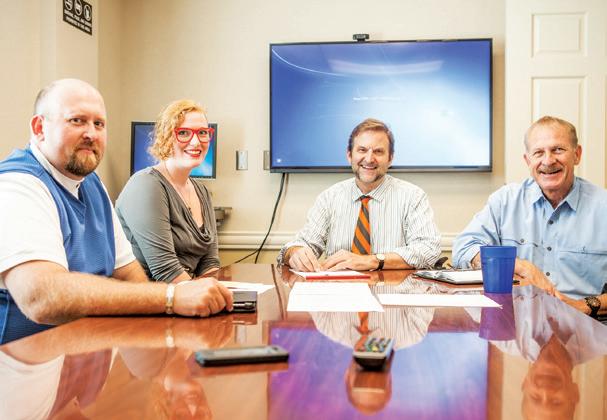
student from the sociology department is also working on the project. College of Education grants specialist Tim Schlais is lending his expertise as well.
The project uses communitybased participatory research models to design and evaluate initiatives and outcomes. Data will be gathered continuously to develop guidelines for future partnerships as well as details on outcomes that can be used to apply for funding to sustain, further and create new initiatives. Initiatives require the support and participation of community members to ensure they can be sustained with or without OSU support.
“The partnership is meant to foster the community’s sense of togetherness and encourage community members to participate,” Romans says.
“(This project) is certainly helping in the short term, but I believe the long-term payoff will be tremendous,” Sumrall says. “We have a vision for our community to come closer together. I’m so grateful that OSU has taken us under its wing. I can’t say thank you enough.” V
CHRISTY LANG
To learn more about the Building Resilient Communities project visit education.okstate.edu/osubrc
The OSU Building Resilient Communities program is partnering with the Coyle School District to develop initiatives to strengthen the school. Some of the team’s members meet for a roundtable discussion, including (from left) Coyle superintendent and school administration doctoral student Josh Sumrall, counseling psychology doctoral student Fae Frederick, counseling psychology professor John Romans and school administration professor Ed Harris.
27 Research at Oklahoma State University • www.vpr.okstate.edu
PHOTO/MITCH HARRISON
Diversity PAYS OFF
Research suggests differences can make us smarter
Let’s say your company intends to build its own answer to the red-hot GoPro action camera stuck on the wrists and helmets of virtually every self-respecting extreme sports freak on planet Earth. Where should your company start? What should your design team look like?
Look toward diversity for top results.
Research conducted by Cynthia Wang, an associate professor in the Department of Management at the Spears School of Business, suggests mixing people of different races, ethnicities, cultures, genders, political persuasions, etc., within a workforce benefits workers and companies.
Diversity, it seems, makes people smarter.
“Diversity can have a very positive impact on group performance,” Wang says.
It’s more than simple exposure to different perspectives. Working with different types of people stimulates more thought — and here’s a key finding — just before meeting that person, Wang’s research shows.
So a person works harder in preparation. And smarter.
Then when you meet as a group with this person, you actually perform better because of that,” Wang says.
Wang’s team gathered 186 people who identified themselves as Democrats or Republicans and asked them to read and crack a murder mystery. Subjects wrote essays explaining who they thought was the murderer. All participants were told their partner disagreed with their opinion. Half were told they would use their essays to help make their case to someone of the opposing political party and half were told they would need to convince a member of their own party.
“If you’re making the right decisions within a group, that can definitely translate into better decisions overall for the organization.”
—Cynthia Wang
When meeting someone of a different race, “just knowing that you’re actually going to meet that person in the future, that starts preparing you in a particular way that actually ends up benefiting group performance,” Wang says.
Research suggests this advantage extends right into tasks taken on by the group as a whole.
“You actually analyze the information more thoroughly.
Researchers found subjects of both parties prepared less for the discussion when told that their disagreeing partner was of their same party affiliation. This suggests disagreement from a socially different person makes people work harder.
Diversity jolts the mind into action in ways that sameness simply does not, noted a recent article in Scientific American that described Wang’s work.
The surprise benefit from diversity translates into everyday life outside that imaginary flashy camera company, too.
“Instead of maybe being apprehensive about working with somebody who’s different from us,” Wang says, “this could be an opportunity to say, ‘Hey, there might be actually huge benefits to not only the organization but to myself by working with these different types of people.’”
How does this finding translate into dollars and cents for businesses?
Research at Oklahoma State University • www.vpr.okstate.edu 28
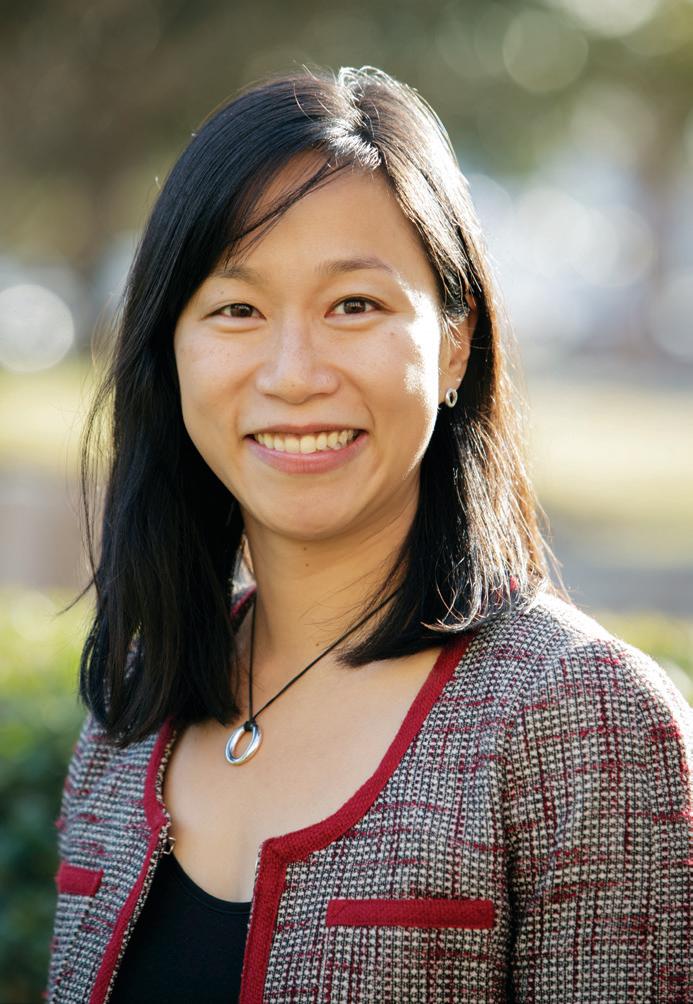
“If you’re making the right decisions within a group, that can definitely translate into better decisions overall for the organization and, as a whole, help your bottom line,” Wang says.
An Explosion of Cultures
Wang’s interest in diversity research grew perhaps naturally out of her upbringing, raised in Boston and central Illinois by Taiwanese parents.
“I feel very diverse, I guess,” she says.
Along with her diversity research, Wang also researches how different cultures respond to ethical and unethical behavior. As a Northwestern University graduate student, she became fascinated with the ethical field as the world watched corporate fraud and corruption famously unravel big companies such as Enron, WorldCom and Tyco International in late 2001 and 2002.
“When I was in graduate school, there were a lot of explosions on the ethical front. So you can think of Enron, Tyco. Things were melting down,” she says.
Executives with former energy trading company Enron recorded fake revenues through their shell companies that made earnings appear fabulous. Shady transactions further concealed tremendous debt, and the media found that big banks worked with executives to hide these deals. Ultimately,
Enron’s chief auditor ordered the shredding of thousands of documents in an attempt to conceal the cooked books that helped bring down the company in December 2001.
In the case of Tyco International, the former chief executive and former finance chief were convicted in 2005 of stealing more than $600 million from the company to finance lavish lifestyles that included luxuries such as a $6,000 shower curtain and a $2 million toga birthday party.
“So I was thinking, ‘Why is this really happening?’ ” Wang says.
“I wanted to know why people weren’t responding to this negative behavior and how did it get to this point?”
Wang’s research provides insight into these issues and why business misconduct and criminal activities may became bolder and bolder. Her team’s study has shown that people reward honesty more often and intensely than they punish deception.
People are twice as likely to reward an honest person as punish a deceptive one. And the reward amounts for honesty are 16 to 24 percent larger than the punishment amounts meted out to deceivers, her work suggests.
The research also suggests that people prefer to avoid a deceptive person than to approach an honest person. And the tendency to go easy on deception may allow these problems to escalate. The research further suggests that different, complex psychological mechanisms drive punishment and reward.
Wang says part of the issue is how incentives are put together so that people will strive to get a reward but they will cut corners to get there.
“So really understanding how these different types of rewards and punishments affect people I think has really opened my eyes to saying, ‘Hey, there’s a lot of things that are going into these decisions,’ (and) that it’s not always bad people,” she says.
Wang says her research will not end anytime soon.
“My research is completed, well, I guess the day the Tycos stop happening. (When) the big ethical quandaries stop happening.”
That’s probably not going to happen tomorrow, she says. “But if we can alleviate it from happening every 10 years, something like that.” Then, laughing, she adds, “Maybe make it 20 years.”
Wang says her diversity research will probably end when costs and benefits are fully understood and organizations apply that knowledge.
“And then seeing the fruits of that diversity. Let’s say you have diversity policies, but you don’t really know how it impacts the bottom line. Having a clear line between that and trying to understand that would be great,” she says.
“That’s like 200 years from now,” she laughs. V
SONYA COLBERG
Cynthia Wang, associate professor of management, researches benefits of diversity in the workplace and response to unethical behavior in business.
29 Research at Oklahoma State University • www.vpr.okstate.edu
PHOTO / GARY LAWSON
OSU researchers are developing a radiation-shielding material that could be used in the construction of habitats on the moon or Mars
Living in Space
Living on the moon could become a reality through new research from engineering and physics faculty at OSU.
“With fewer and fewer places left to explore on Earth, our attention is turning toward outer space,” says Ranji Vaidyanathan, Varnadow Chair and OSU-Tulsa professor of materials science and engineering. “Living in space is the next frontier for us.”
Funded with a $750,000 grant from NASA, an interdisciplinary team is working to develop a new radiation-shielding material that could be used to construct habitats that protect astronauts from prolonged exposure to galactic cosmic radiation.
Vaidyanathan, Raman P. Singh, OSU-Tulsa Helmerich Research Center director, C.F. Colcord Chair and professor of mechanical and aerospace engineering, and Eric Benton, associate professor of physics,
are project leaders. Victoria Duca Snowden at the Space Grant Program at the University of Oklahoma is administering the project, assisted by Madeline Baugher at Southwestern Oklahoma State University.
The project, “Radiation Smart Structures and Materials with H-rich Nanostructured Multifunctional Materials,” was one of 15 selected for funding through the NASA Experimental Program to Stimulate Competitive Research (EPSCoR) in 2014.
“OSU is a leader in the development of innovative engineering and aerospace technology,” says OSU-Tulsa President Howard Barnett. “The collaborative project demonstrates how research at the Helmerich Research Center in Tulsa is having an impact on industries across the nation as well as in Oklahoma.”
The material will shield astronauts from ionizing radiation during
missions to asteroids near Earth, the moon and Mars and could also be used in the creation of lunar and Martian habitats. Using 3-D printing technology and contour crafting, astronauts will be able to create the parts and construct igloo-like habitats in space, instead of building units on Earth and transporting them.
“Generally, astronauts cannot stay in space for longer than six months because of their prolonged exposure to radiation. After that point, they are at a much higher risk of developing cancer,” says Singh. “The lightweight material we are developing would deflect that radiation and enable space travelers to spend significantly longer amounts of time in space.”
Benton, an expert on radiation shielding, will lead tests on the material to ensure it works under conditions found in outer space. The team will utilize testing facilities
Research at Oklahoma State University • www.vpr.okstate.edu 30
ILLUSTRATIONS
/ DAVE MALEC
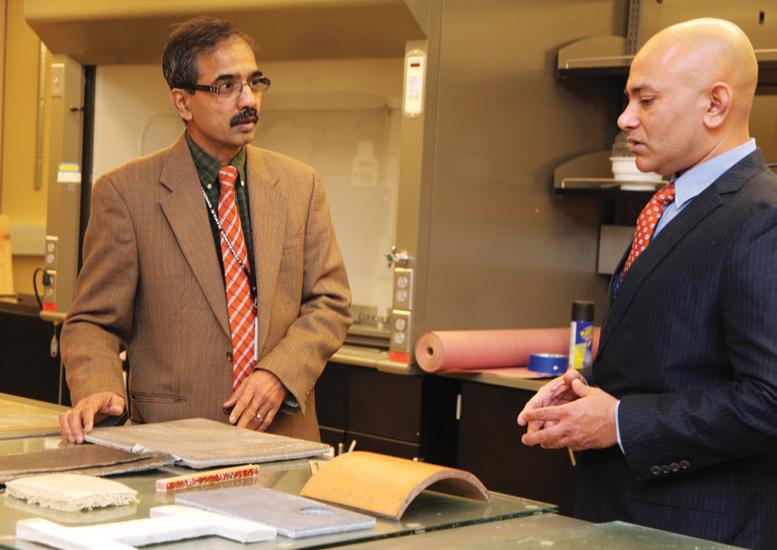
in Chiba, Japan, to assess the material’s effectiveness against highenergy particle bombardment.
“The particle accelerator facility we will be using produced the same type of radiation that astronauts are exposed to during space flight without actually being in space,” says Benton. “We have seen promising results from previous studies and are building on those findings with this study.”
The team is collaborating with scientists at NASA Langley Research Center in Virginia, Marshall Space Flight Center in Huntsville, Ala., and Lyndon B. Johnson Space Center in Houston to find additional applications for the material.
NASA EPSCoR establishes partnerships with government, higher education and industry leaders to foster aerospace research opportunities across the country. EPSCoR provides seed money to develop long-term enterprises that will contribute to the country’s economic well-being and advance the aerospace industry.
“The grant will also provide undergraduate students the opportunity to conduct research that could be utilized in a NASA project,” says Vaidyanathan. “These students are exposed to projects they normally would be involved with as graduate researchers, gain invaluable realworld experience and prepare for future research in materials science, aerospace engineering and physics.”
The project will push the boundaries of space exploration to places humans have only dreamed about before.
The grant will also fund summer research internships for Oklahoma college students in OSU’s materials science and radiation physics laboratories. The internship programs will target students from minority populations through a partnership with the Louis Stokes Alliance for Minority Participation. Students from two-year partner institutions will be able to apply for the program.
“We hope to create a recruitment pipeline for students interested in engineering who would otherwise not be able to participate in this level of research,” says Singh. “It will enhance their résumés and improve the quality of their education, helping them earn higher salaries when they are ready to join the workforce.”
The project will have a significant impact on the state’s economy as researchers are working with several regional companies to develop the material, including CleanNG LLC, the NORDAM Group of Tulsa and ProCure Proton Therapy Center in Oklahoma City.
For Vaidyanathan, the project is a BHAG — a Big Hairy Audacious Goal — that will push the boundaries of space exploration to places humans have only dreamed about before.
“Human beings have always been explorers. There’s a Viking in
all of us,” he says. “We want to be able to go out and explore new things and new ideas. We have dreamed for so long of living in space, so to be able to establish a colony on the moon or Mars would be a great achievement for science and OSU.”
V
SEAN KENNEDY
Ranji Vaidyanathan (left), professor of materials science and engineering, and Raman Singh, professor of mechanical and aerospace engineering, discuss a research project at the Helmerich Research Center, OSU-Tulsa.
31 Research at Oklahoma State University • www.vpr.okstate.edu
PHOTO/COURTESY OSU-TULSA
RESEARCHING HOW TO RAISE CATTLE WITH LESS WATER
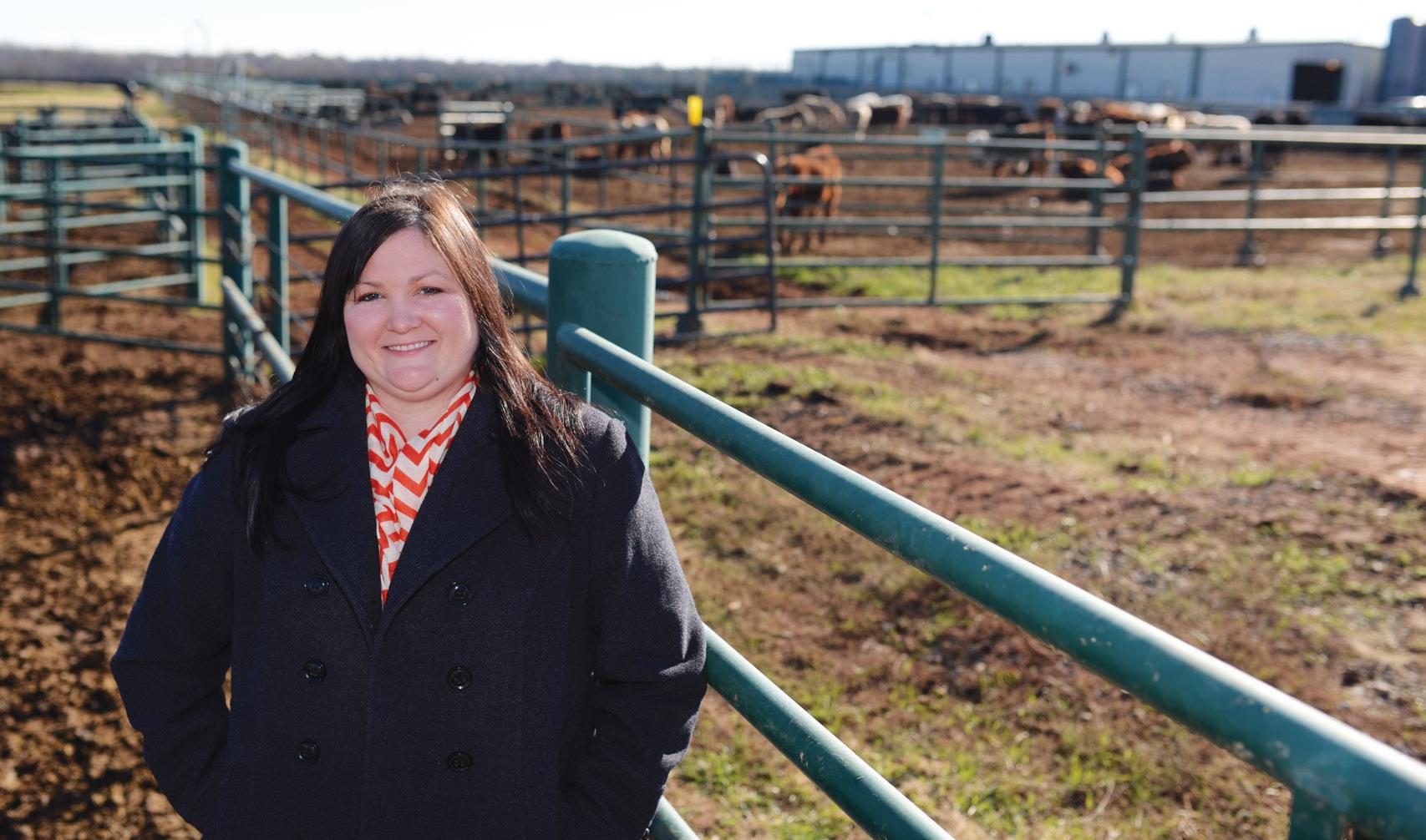
Oklahoma State University is working to provide some of the first water-management adaptation tools for beef producers, thanks to a $1 million grant from the U.S. Department of Agriculture’s National Institute of Food and Agriculture.
“The ultimate goal is to develop beef cattle and production systems that are more readily adaptable to the negative effects of drought,” says Megan Rolf, an assistant professor of animal science with OSU’s Division of Agricultural Sciences and Natural Resources who is the project’s principal investigator.
OSU research will focus on measuring water and feed intake on individual animals. Feed efficiency has been a popular focus among beef cattle researchers for years, but scientists have not focused much on cattle’s ability to manage water.
“If these traits prove to be heritable in beef cattle, we can make selection decisions to improve an animal’s genetic merit,” Rolf says.
OSU’s Willard Sparks Beef Research Center is equipped with an Insentec system, which allows the collection of individual animal water intake in a pen setting. This technology makes possible the large-scale study of these traits in beef cattle in a normal feedlot environment.
“If these traits prove to be heritable in beef cattle, we can make selection decisions to improve an animal’s genetic merit.”
—Megan Rolf
“Water efficiency is not a traditionally economically important trait, but water is becoming more important as we move into the future, not only because of drought but also increased competition for limited water resources,” Rolf says.
Although large-scale water-intake studies have not been performed on cattle because of technological limitations, similar research has been conducted with other animals in laboratory settings, and water intake was a heritable trait in those species.
The $1 million project is the first of its kind, focusing on the measurement of water-intake efficiency at the same time researchers are measuring feed efficiency on a large scale. Paired with extensive weather, genomic, animal health and animal behavioral data, this project will yield a powerful dataset with which to explore selection and management for adaptation to drought in beef cattle.
The potential benefits to the state economy are significant. More than half of agricultural cash receipts in Oklahoma are from cattle and calves, according to National Agricultural Statistics Service data.
“Oklahoma is the nation’s fifth-leading cattle-producing state and is one of the southern Great Plains states suffering through historic drought in recent years, underscoring the importance of research that enhances beef cattle production,” says Clint Krehbiel, co-principal investigator and research coordinator for the OSU Department of Animal Science.
Research at Oklahoma State University • www.vpr.okstate.edu 32
PHOTOS / TODD JOHNSON
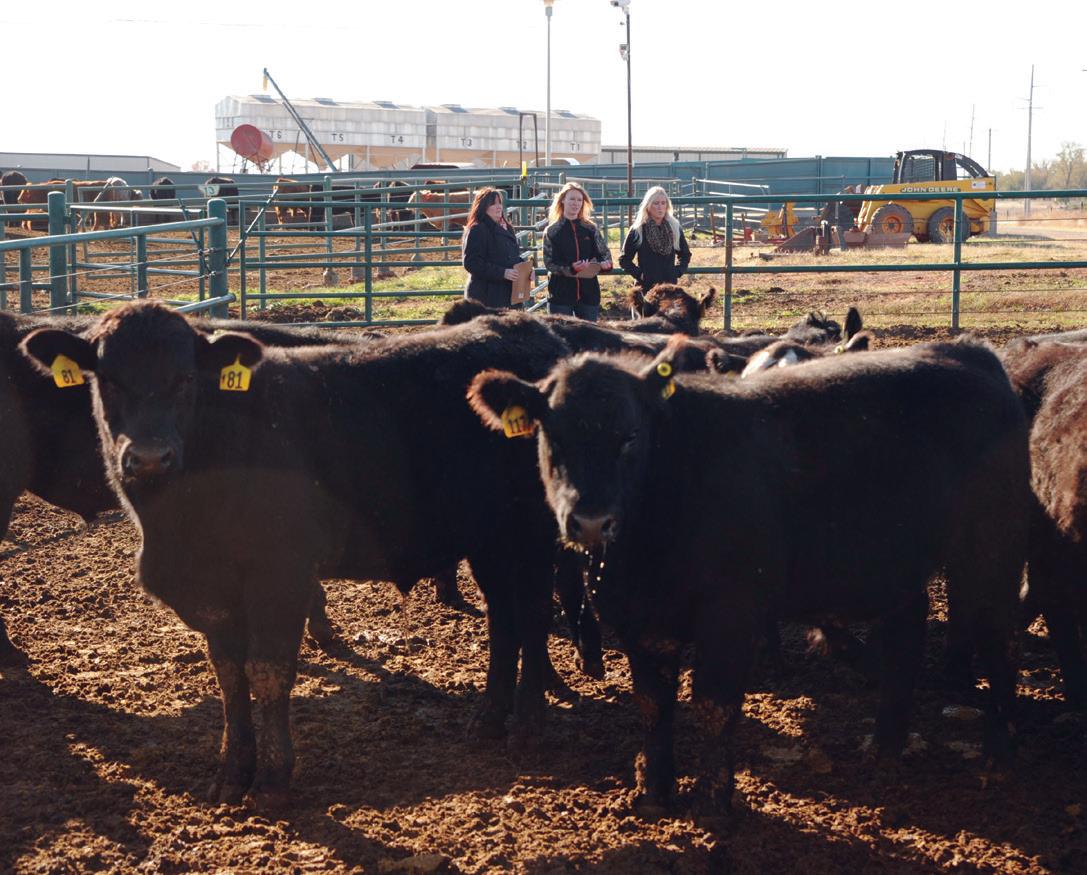
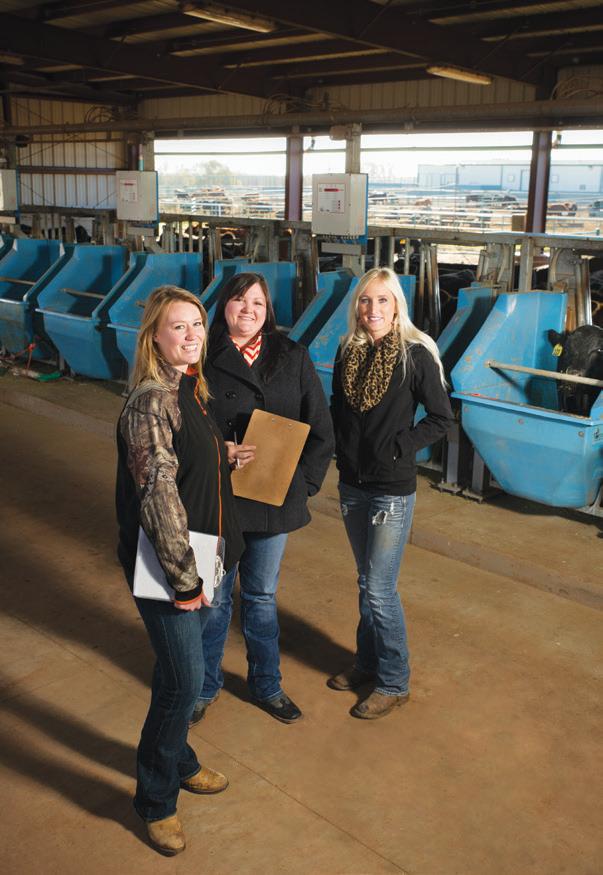
“Improving the quality of life for beef producers can have a significant positive effect on them and their families, and by extension, the communities where they live.”
Rolf agrees, adding that improved management tools are vital to allow beef producers to better manage operational risk and existing natural resources.
“An important aspect of this study is that scientists are taking research results and tying them directly into decision-support tools producers can use,” she says.
One of the primary outcomes of the project is the development of a water management tool, working in conjunction with the Oklahoma Mesonet, a world-class network of environmental monitoring stations designed and implemented by scientists at OSU and the University of Oklahoma. The system consists of more than 120 automated stations across the state, with at least one Mesonet station in each of Oklahoma’s 77 counties.
“Oklahoma beef producers already have access to a ‘cattle comfort index’ through the Mesonet system,” Rolf says. “This allows them to fine-tune operational management decisions related to animal well-being, and to essentially do so in real time, as well as forecast possible future concerns.”
A major objective of the project is to expand the “cattle comfort index” so the information provided is usable by beef
producers no matter where they are in the nation. Longer term, the project scientists, along with the Oklahoma Mesonet, will focus on developing a water resource management tool.
“Given the world’s ever-increasing population, it is more important than ever to develop and promote beef production systems that are economically sustainable for both producers and consumers while also fostering environmental stewardship,” Krehbiel says.
NIFA made the award through its Agriculture and Food Research Initiative (AFRI) funding opportunity in the Climate Variability and Change challenge area. NIFA’s climate work is focused on reducing greenhouse gas emissions and increasing carbon sequestration in agricultural and forest production systems and preparing the nation’s agriculture and forests to adapt to changing climates.
AFRI is NIFA’s flagship competitive grant program, established under the 2008 Farm Bill, and supports work in six priority areas: plant health and production and plant products; animal health and production and animal products; food safety, nutrition and health; renewable energy, natural resources and environment; agriculture systems and technology; and agriculture economics and rural communities. V
DONALD STOTTS
from the USDA to provide the first water-management tools for beef producers. $1 MILLION GRANT
OSU animal scientist and assistant professor Megan Rolf (photo page 32) is leading research into creating herd management tools to help producers develop cattle adaptable to managing water use. Rolf (photo above right) and graduate students Ashley Broocks (left) and Kristi Alwardt monitor cattle involved in the research.
33 Research at Oklahoma State University • www.vpr.okstate.edu
Research faculty honored with Regents Distinguished Research awards
Each year, Oklahoma State University honors research faculty with the Regents Distinguished Research Award. Recipients are selected based on evidence of outstanding and meritorious research achievements and are recognized nationally and internationally in their fields of study. In 2014, five OSU faculty members were honored with the award. JEFF JOINER
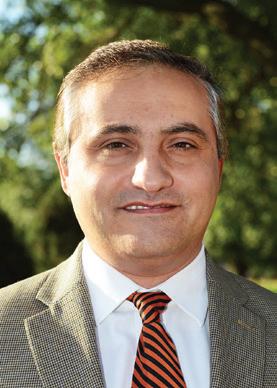
MURAT HANCER , professor
School of Hotel and Restaurant Administration, College of Human Sciences
Hancer’s research focuses on hospitality human resources management and hospitality information technology. He is particularly interested in the effects of restaurant employee job satisfaction on service quality and has written widely on the topic. Hancer believes psychological empowerment of hospitality industry workers can lead to improved employee satisfaction and service quality in the restaurant industry.
His publications include 45 peer-reviewed journal articles, 65 peer-reviewed conference papers/presentations, three books and three
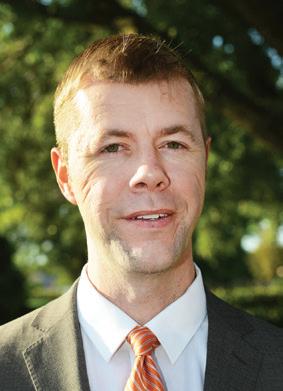
book chapters. His work has been cited more than 350 times. He is a coordinating editor of the International Journal of Hospitality Management and serves on the editorial boards of six scholarly journals. He, along with graduate students and colleagues, received six best-paper awards in the last five years.
In 2011, he received the Outstanding Graduate Faculty Mentor Award in the College of Human Sciences and the universitywide Outstanding Graduate Coordinator award in 2012.
TYLER LEY, associate professor and Williams Foundation professor
School of Civil and Environmental Engineering, College of Engineering, Architecture and Technology
Ley investigates using material science to improve constructions materials, the development of sensors to monitor roads and bridges, and the imaging of the structure and chemistry of materials at the micron and nano scales. In his six years at OSU, his research has been awarded more than $8.8 million in grants, including the funding of 32 projects where he was the principal investigator. His work has led to five patent applications. His research has been published in 45 peer-reviewed publications, and he has co-authored 25 industry reports with his students. He is actively collaborating
on research projects with a variety of OSU departments. One project with the College of Education involves developing an engineering-based curriculum for fifthgrade students. He is also collaborating on projects with nine other universities.
In 2014, Ley was recognized with the American Concrete Institute Walter P. Moore Award, the organization’s highest academic honor. A passionate teacher, Ley received the 2011 Halliburton teaching award and the Chi Epsilon Honor Society Teacher of the Year award in 2009.
Research at Oklahoma State University • www.vpr.okstate.edu 34
PHOTOS PROVIDED
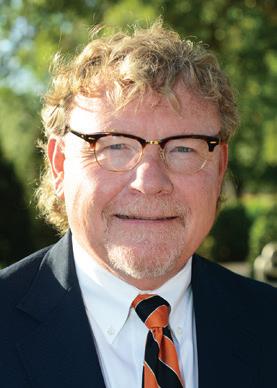
LARRY L. MULLINS, Regents professor and Vennerberg professor of psychology
College of Arts and Sciences
In his 30 years as a psychology researcher and teacher specializing in pediatric psychology and child health psychology, Mullins has focused on risk and resistance factors that predict adjustment outcomes in children with chronic health conditions. His research includes a broad array of children’s health issues and disorders and the development of empirically supported psychological interventions for the parents of these children.
Mullins has served as the principal investigator on 14 grants. He has been named to the editorial board of five major journals
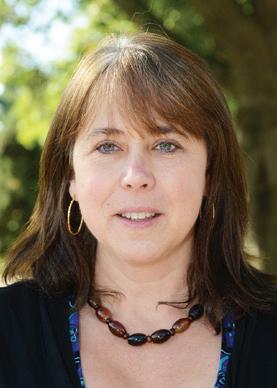
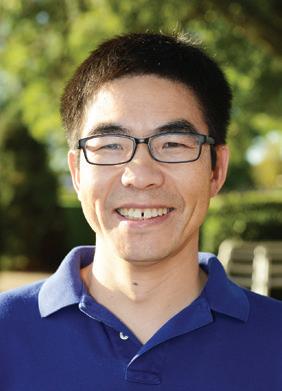
in psychology and is the associate editor for the journal Clinical Psychology in Medical Settings. He has been named a fellow of the Society of Pediatric Psychology (Division 54) and of Family Psychology (Division 43) of the American Psychological Association.
As an instructor and mentor, he has graduated 13 doctoral students, most of whom have gone on to research careers in psychology. In 2006, he received the Martin Levin Mentorship Award from the Society of Pediatric Psychology.
JEANMARIE VERCHOT, professor of entomology and plant pathology
Division of
Agricultural Sciences and Natural Resources
Verchot established her laboratory at OSU in 1998 to investigate viral pathogens affecting agriculture and horticulture plants. She and her team have made important discoveries in the areas of viral-vector relationships, viral diseases of wheat, mechanism of virus movement from cell to cell, virus interactions with the host endomembrane network and cellular stress response. Her research was been awarded more than $6 million in state and federal funding.
The Verchot laboratory has done important research into the relationship between a wheat mosaic virus and its vector that has been widely
referenced. She also studied the intercellular movement of a potato virus that launched broader research into the role of cellular membranes in supporting virus infection. The project resulted in a Cambridge University sabbatical for Verchot to study oxidative stress and cell death responses to virus infection. She has published 83 scientific articles, and her work has been cited more than 1,500 times, excluding self citations.
JIAHONG WU, Regents professor of mathematics College of Arts and Sciences
In his research, Wu examines the applications of several nonlinear partial differential equations, which are fundamental in understanding many fluid phenomena from small-scale blood flows to large-scale geophysical flows.
Some of his most important work has been the investigation of equations that model large-scale movements of the atmosphere and oceans, including weather systems such as hurricanes. Another important area of his research includes the study of the vanishing viscosity limit of the Navier-Stokes equations, which model events important in
understanding topics including machinery lubrication, airflow around wind turbines and large-scale atmospheric and ocean flows.
Wu has authored more than 70 journal articles and co-authored a monograph. His work has been cited more than 1,300 times. He has earned a number of awards including the Centennial Fellowship from the American Mathematical Society and the Ralph E. Powe Junior Faculty Enhancement Award from Oak Ridge Associated Universities. His work has been supported by the National Science Foundation and the American Mathematical Society.
35 Research at Oklahoma State University • www.vpr.okstate.edu
OSU innovation sets another royalty record
OSU wheat varieties lead the way in growth
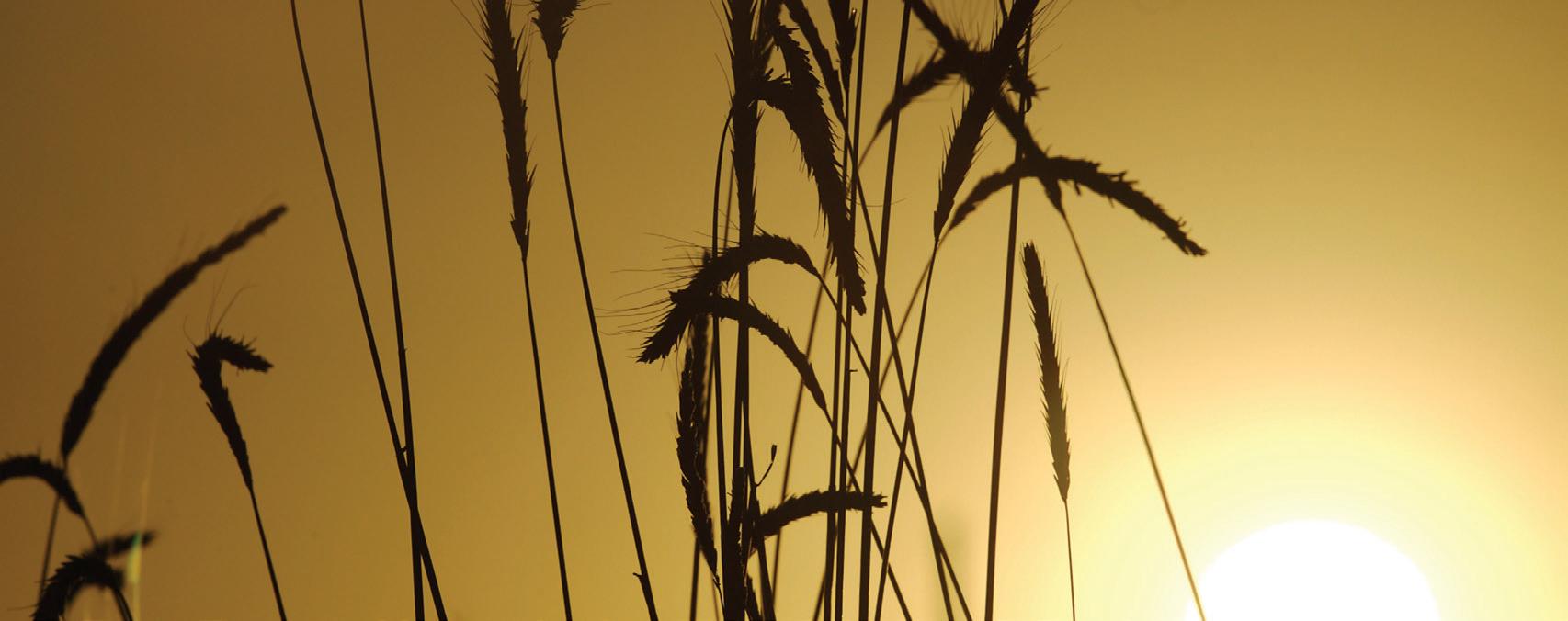
The OSU Technology Development Center has set a new record for licensing income of $2.2 million in 2014. The TDC, Oklahoma State University’s intellectual property licensing and protection office, broke the $2 million revenue threshold in 2013 when it reported $2.1 million in license royalty revenue. Royalties are generated from OSU-developed intellectual property licensed to private companies.
“The increase in royalties overall is largely due to the growth in licensing revenue from our wheat varieties,” says Steven Price, associate vice president for technology development and TDC director. “Those revenue numbers are growing faster than any other license.”
$2.2
With experience improving wheat genetics dating to the 1940s, OSU plant scientists, pathologists and molecular biologists continue to improve and commercialize winter wheat varieties now planted on 47 percent of the more than 5 million acres of wheat in Oklahoma. The OSU interdisciplinary Wheat Improvement Team, organized in 1998 in the Division of Agricultural Sciences and Natural Resources, has commercialized 13 varieties of hard winter wheat that have been
licensed by Oklahoma Genetics Inc. In 2014, more than $485,000 in revenue was generated by these OSU-developed varieties.
Oklahoma wheat growers face a number of challenges, including a variety of diseases and a continuing drought in much of the state. OSU scientists have improved wheat genetics to make them adaptable to Oklahoma conditions. Targeted traits include those necessary for high yields, superior quality, disease and insect tolerance, excellent milling and baking characteristics and excellent grazing potential. These successful varieties have helped make Oklahoma the second-largest hard
“It can be quite nimble under a wide range of conditions,” he says. “Both cattle producers and grain producers prefer it.”
Royalties from these and other licensed technologies are reinvested into university research programs. Royalties support the TDC’s Technology and Business Development Program, an initiative that seeks out research projects with high commercial potential and supports them to the point of licensing. TBDP funds prototype development and feasibility demonstrations, since the projects are often too specific for federal funding and too basic to get normal industrial support.
red winter wheat producer, behind only Kansas, says Brett Carver, OSU Regents professor of wheat breeding and genetics and director of the Wheat Improvement Team.
OSU wheat varieties, with such colorful names as Gallagher, Ruby Lee and OK Rising, each claim unique characteristics making it ideal for specific conditions. But no other OSU variety does as well as Duster, a variety Carver calls a workhorse that is the leading OSU variety for wheat royalty revenue.
For startup companies, the university partners with Cowboy Technologies LLC, a for-profit company that develops early-stage OSU technology companies until they are ready to be stand-alone entities (see the story “Spinning Off OSU Technology,” page 14). Cowboy Technologies provides management, marketing expertise and seed funding to help new companies navigate these critical phases of technology development.V
JEFF JOINER
PROVIDED
PHOTO
For information about the TDC and licensing OSU technologies, visit tdc.okstate.edu.
MILLION
LICENSING REVENUE
2014
Research at Oklahoma State University • www.vpr.okstate.edu 36
Growing the Numbers
Research at Oklahoma State University • www.research.okstate.edu $200 $180 $160 $140 $120 $100 $80 $60 $40 $20 $0 ’13* ANNUAL RESEARCH EXPENDITURES IN MILLIONS OF DOLLARS ’04 ’05 ’06 ’07 ’08 ’09 ’10 ’11 ’12
12 10 8 6 4 2 0 NUMBER OF PATENTS GRANTED ’04 ’05 ’06 ’07 ’08 ’09 ’10 ’11 ’12 ’13 $2.25 $2.0 $1.75 $1.5 $1.25 $1.0 $.75 $.5 $.25 $0 OSU INCOME FROM LICENSES (IN MILLIONS OF DOLLARS) ’13 ’04 ’05 ’06 ’07 ’08 ’09 ’10 ’11 ’12 ’14 50 45 40 35 30 25 20 15 10 5 0 NUMBER OF LICENSES YIELDING INCOME ’13 ’04 ’05 ’06 ’07 ’08 ’09 ’10 ’11 ’12 ’14 ’14 ’14*
Annual Research Expenditures (2004 – 2014) Intellectual Property (2004 – 2014)
*Figures for 2013 and 2014 exclude expenditures from the Oklahoma State University – University Multispectral Laboratories.
37
The nexus of mathematics and art
Henry Segerman holds up an intricate object with three teethed gears enmeshed to form interlaced rings. Insert a threaded rod into the center, and the gears rotate smoothly.
The “triple gear” looks like something that would have all kinds of industrial applications, but Segerman laughs. “I mean, this is a mathematics department,” he says, with a wry smile.
Segerman, an Oklahoma State University assistant professor of mathematics, creates complex geometric objects using mathematical principles rendered in software and fabricated using 3-D printers. He is a member of a community of artists who create a nexus between mathematics and art using technology to translate the abstract into reality.
Segerman says practical uses are not his priority. He’s creating geometric objects that allow people to hold the conceptual in their hands.
“Some see these objects as purely art,” Segerman says. “Another way of looking at it is taking something that’s difficult for people to understand and making it accessible, so that they can touch it and understand the shapes.”
Segerman’s research involves threedimensional geometry and topology, and mathematical visualization.
An online 3-D printing service uses a laser to melt plastic dust in successive layers to fabricate objects. The technology is ideal for creating accurate models of mathematical concepts, he says.
“We can produce a physical object that is very precise and faithful to the mathematics,” Segerman says. “There’s a lot of interesting mathematics in how you define a surface in a computable way and using that knowledge to make a physical object.”
Just as mathematicians have used physical models as teaching tools for centuries, Segerman uses 3-D objects to illustrate geometric surfaces. Because it is often difficult for calculus students to visualize these surfaces, an object that they can hold in their hand is revealing.
“Now, instead of drawing it on the board, you can hold this object up in front of a class,” Segerman says. “And they say, ‘oh yeah, I see it.’ Then they can think about the algebra behind the surface.”
Segerman accepts the title of artist, refining it a bit. “I’m a mathematician and a mathematical artist.”
Segerman insists he’s more of a visualizer than a pure artist. “I appreciate the emotional aesthetic of this, but what I’m trying to do is make the best model that I can that is true to the mathematical idea behind it.”
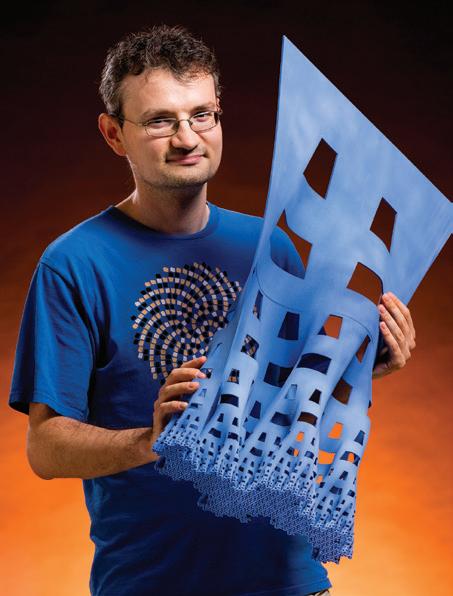
Segerman is planning an undergraduate class for the spring of 2016 in mathematical visualization. “Though this is not necessarily for math majors, we’re going deeper into the mathematics of computationally defining an object,” he says.
“There’s a magic to this,” he adds. “Here is a virtual thing on a computer screen, and here’s the real thing. You’re experiencing it in a new way.”
JEFF JOINER
For more information about Segerman’s 3-D models, visit math.okstate.edu/people/segerman/.
Non-Profit U.S. Postage PAID Stillwater, OK Permit #191 Oklahoma State University Office of Vice President for Research 203 Whitehurst Stillwater, OK 74078-1020
PHOTO / PHIL SHOCKLEY
Henry Segerman, assistant professor of mathematics, holds an object he created using computer software and a 3-D printer. The piece was part of Segerman’s featured exhibit of 3-D geometric sculptures at Stony Brook University in Brooklyn this summer.













 American Indians Into Psychology program director John Chaney (right) and graduate adviser Patricia Alexander (left) with OSU psychology graduate students who have participated in AIIP: (from left) Victoria O’Keefe, Sean Seabridge, Ashley Cole, Kristen Frosio, Ashleigh Coser and Trey Fogleman.
American Indians Into Psychology program director John Chaney (right) and graduate adviser Patricia Alexander (left) with OSU psychology graduate students who have participated in AIIP: (from left) Victoria O’Keefe, Sean Seabridge, Ashley Cole, Kristen Frosio, Ashleigh Coser and Trey Fogleman.

















 OSU’s Robert M. Kerr Food & Agricultural Products Center offers assistance to entrepreneurs who are interested in starting their own food businesses. (Top) Darren Scott, FAPC food scientist and sensory specialist, uses a bowl chopper in the making of homemade salsa.
(Bottom) Erin Johnson, FAPC business and marketing client coordinator, checks the temperature of a food product before pouring into jars.
OSU’s Robert M. Kerr Food & Agricultural Products Center offers assistance to entrepreneurs who are interested in starting their own food businesses. (Top) Darren Scott, FAPC food scientist and sensory specialist, uses a bowl chopper in the making of homemade salsa.
(Bottom) Erin Johnson, FAPC business and marketing client coordinator, checks the temperature of a food product before pouring into jars.
























